How to Write a Case Study in APA Format
Table of contents
- 1 What Is a Case Study In APA Format?
- 2.1 Sample Of APA Case Study Outline
- 3.1 Title Page in APA for Case Study Project
- 3.2 APA Title Page Example
- 3.3 The Abstract for an APA case study
Whether you study social sciences or life sciences, you’re likely to encounter a case study analysis in your academic journey. These papers demand a lot from students. First, you must have impeccable research and analysis skills. Sample populations, particularly people, can be challenging to analyze. It’s easy to misinterpret data and come up with the wrong conclusions. Additionally, you’ll need to have a knack for writing to present your findings persuasively, backed up by evidence-based arguments that build confidence for your teacher to accept the results of your work. If you need to boost your paper, Papers Owl is here to help you with a wide range of guidelines on how to write a case study in APA.

What Is a Case Study In APA Format?
To make your success, first realize that a case study is detective work. Your research may have an unresolved question or to carry out some testing to validate a hypothesis; in this case, studies are born. Psychology, nursing, and business are common fields this method is applied. In this scientific method, you’ll approach an event, action, individual, etc. And apply a set of circumstances to observe outcomes. Most papers in this field are written in the APA format, which can be a burden for students, especially if they aren’t familiar with this style. If you lack time or motivation for writing, appeal to our professional writers to write a case study in APA format, and we will ensure your paper is perfectly formatted and gets a high grade.
Structure of Case Study Report In APA
First, let’s look at the sections in writing a case study in APA, which shares a few similarities to a typical research paper.
Introduction: Introduce your topic to the reader. Be sure to include the state of current research and where you plan to develop the current state of knowledge. You should include an interesting fact to reinforce your work’s importance and develop an interest in your hypothesis. Finish off with a thesis statement that you’ll focus on your workaround.
Aims: In this section, you answer the questions regarding why you are conducting your research and any questions you’ll explore. Avid case study writer recommends focusing your questions around your thesis. You can develop a triangle with a diagram and drill down your questions in a logical format that matches your paper’s main purpose.
Methods: Writing a case study in APA requires a methods section that details how you conducted your research. Did you conduct any interviews, send out questionnaires, or observe any behaviors? Detail them in this section, and state the environment and circumstances surrounding your data collection.
Results: Now that you’ve identified what you’d planned to accomplish and how you went about it in your APA case study format, it’s time to post the results. Don’t be shy if things don’t go swimmingly. Often in studies, we have unexpected results, which sometimes makes your paper more interesting to read.
Discussion: It’s time for the heart and soul of your paper. After all your research and observation, it is time to have a discourse on the results. The key to how to write a case paper in APA hangs on your ability to interpret the results in a meaningful way. Be sure to focus the discussion on your stated methods and how they pertain to your aims.
Recommendations: Here you want to detail what is to follow your research. Professional case study writers advise stating any knowledge gaps in your work and any unanswered or new questions you had found in the process. Your insights will be useful for others to follow in your footsteps and expand on your analysis.
Sample Of APA Case Study Outline
Example of writing a case study analysis in APA format:
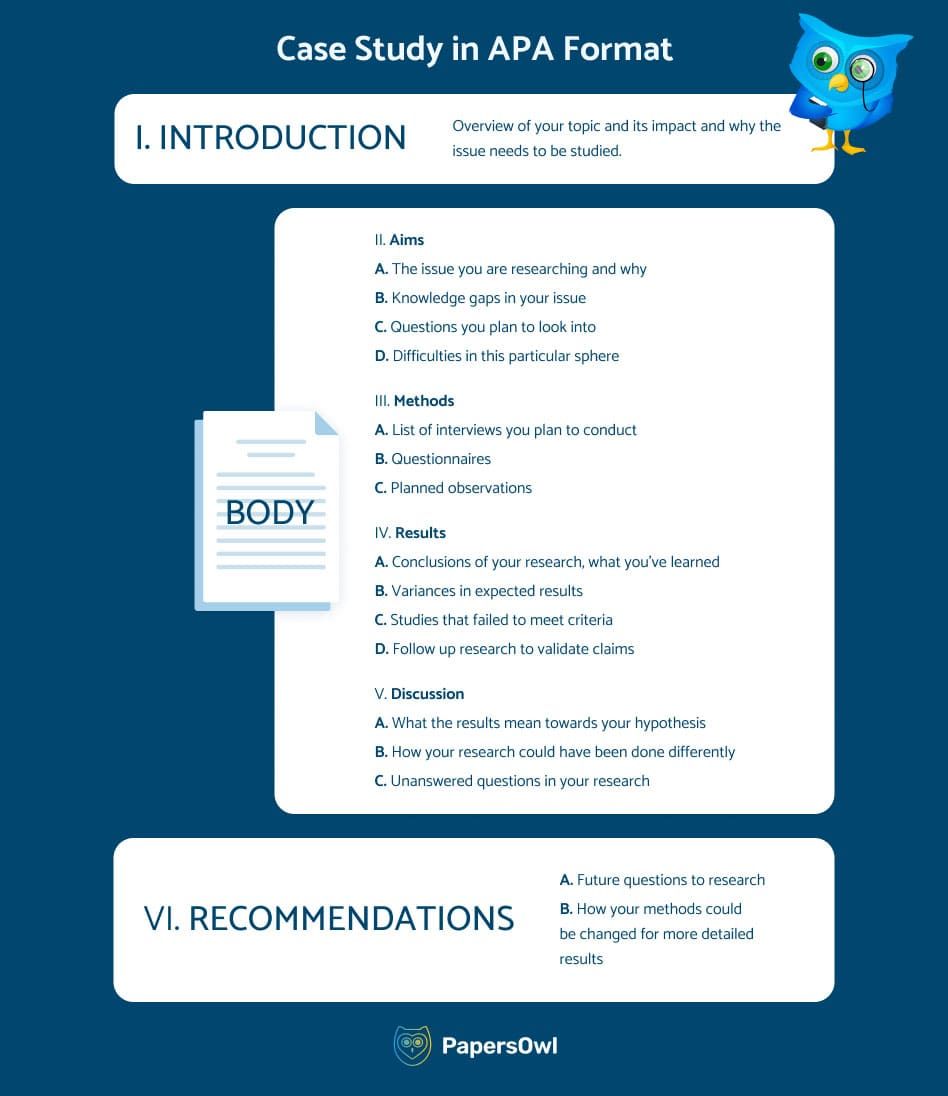
Writing a case study in APA Step By Step
Knowing how to write a case study in APA format is a common question for students. In addition to the typical academic standards, APA has its own requirements that must be adhered to. The first step is to create a heading, known as a running head, that will be present on each page of your paper. The running head includes:
- The page number on the right margin
- A shortened title of your paper in ALL-CAPS no longer than 50 characters to the right

Title Page in APA for Case Study Project
The title of a case study in an APA paper is a requirement. The purpose is to state the name of the work, who the author is, and the institution that sponsored the research. It has the following parts:
- The words “running head” at the top, followed by the actual running head
- The full title of your paper using APA titling no longer than 12 words
- Your name without any designations (Dr/Ph.D./Rev/etc.) and the institution you attend
For APA Style ( 7th edition ), the cover page should also have:
- A page number at the top right corner.
- The institutional affiliation where the research took place.
- Course information, which is mandatory for student papers.
- The author’s note is optional and usually appears in professional papers.
- Font options have expanded to include Calibri 11, Arial 11, Lucida Sans Unicode 10, Times New Roman 12, or Georgia 11.
- All text on the title page should be double-spaced.
- Center all page contents and capitalize the first letter of significant words.
Note: APA 7 distinguishes between the formatting of title pages for professional and student papers. For instance, professional papers include a running head, while student papers do not necessarily include one.
APA Title Page Example
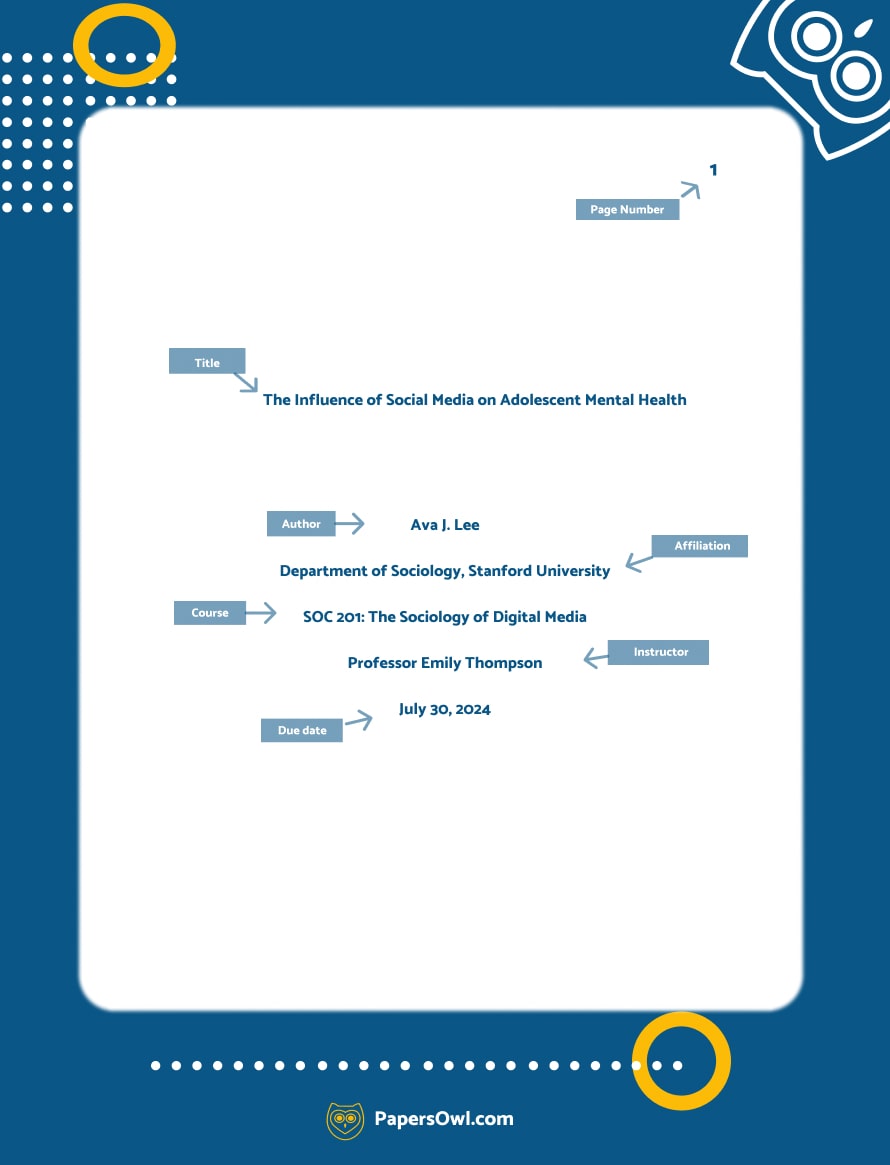
The Abstract for an APA case study
The abstract of your paper works as a summary to give a brief overview of what it contains. Include the running head at the top; the first line should have the word “abstract” centered. Follow the abstract with 150-250 words summarizing your paper. You may also index some keywords to help find the contents of your work in academic databases. At the end of your summary, indent once, and in italics, indicate keywords related to your work.

Writing an effective college paper requires a lot of planning and formatting to get it done right. Brush up on these guidelines for how to write your paper in APA format . If you need someone to review your work or write any parts of your paper, reach out to our professional writers, who are always willing to lend a hand.
Additionally, with the help of our blog, you can make sure you create a professional PowerPoint presentation that clearly outlines the main points of your paper. If you need help with this, our professional writers can provide guidance.
Readers also enjoyed

WHY WAIT? PLACE AN ORDER RIGHT NOW!
Just fill out the form, press the button, and have no worries!
We use cookies to give you the best experience possible. By continuing we’ll assume you board with our cookie policy.
- How to Order
Writing A Case Study
Case Study Format
Simple Case Study Format for Students to Follow

People also read
A Complete Case Study Writing Guide With Examples
Understand the Types of Case Study Here
Brilliant Case Study Examples and Templates For Your Help
Having trouble making your case studies stand out? Finding it hard to organise your story? You're not alone!
Many students struggle with case study writing !
Imagine spending a lot of time on your case studies, but they don't grab your reader's interest. But don't worry!
In this guide, we will go step by step through case study formatting, along with practical tips to make your research stand out from the rest! By following our step-by-step approach, you can understand how to write a case study assignment well.
So, let’s get started!

Paper Due? Why Suffer? That's our Job!
- 1. How to Format a Case Study
- 2. Case Study Format Template
- 3. Case Study Format Examples
How to Format a Case Study
When it comes to crafting a compelling case study, understanding how to write case study format is key to presenting your research effectively.
If you are wondering how to make case study format, here are the elements to include in your case study paper format.
Create an interesting title for your work. Keep it simple and short.
Here you need to briefly elaborate on the accomplishment. What you have done and how you got there.
Write about the entire story in one paragraph followed by 2-3 bullet points to display the case study contents.
An introduction about what the case study is all about.
Describe the challenges of the customer prior to using your product or service. Explain the long-term goals or objectives that the customer set out to achieve.
In this 2-3 paragraph section describe how your product or service specifically benefited and helped achieve the goals. You can also use percentages to show your contributions.
In the relevant section of your case study, add 1-2 quotes and visuals to support the story you are telling. You can also use icons to summarise information and highlight areas of your research.
Figure out what a study means and look at where else we can learn more are really important for making academic work have a bigger impact.
Call to action is optional but adding one can encourage your readers to take some action after learning your work.
Case Study Formatting Guidelines
Effective case study formatting is essential to convey your insights clearly and engage your audience. Follow these guidelines to ensure your case study is well-organised and impactful:
- Opt for easily readable fonts like Arial, Calibri, or Times New Roman.
- Maintain a consistent font size, typically 12 points for the body text.
- Set line spacing to double-spaced for the entire document.
- Use bullet points for concise and scannable information presentation.
- Employ numbered lists for sequences of steps or chronological order of events.
- Bold or italicize key phrases to draw attention to critical points; use underline sparingly.
- Choose left, center, or justified alignment based on your overall design.
- Make your headings clear and organized so readers know what's important.
If you need further assistance, check our case study format for students pdf here:
How To Write A Case Study Pdf
Case Study Format Template
Case studies can be used for different purposes. In social sciences, it can help you understand the problems of other people.
In businesses, it can help you earn the trust of potential customers. But do you even know what are the different types of case study and how to write one?
Refer to this case study format pdf before you start writing your own document. This student case study format sample contains all the information you might need when gathering information for your case study.
Case Study Format Examples
Case study examples are the best way to learn the basic techniques for writing a great case study on your own.
Explore these short case study sample pdfs to gain insights into presenting your research cohesively:
For your help, we have also compiled real-life case study examples along with a format that you can refer to while writing your own.
APA Case Study Format
If you are asked to write a case study in APA format, keep in mind there are some specific requirements that you need to adhere to.
Here is a case study APA format example for you to learn how to format a case study.
Business Case Study Format
Business case studies can help businesses sell products or services to prospects. Here is a perfect example for you to learn how to write an impressive business case study.
Case Study Format For MBA Students
Case Study Format Nursing
Writing a great nursing case study can be tough. That’s why we have provided a case study format for nursing students to use as a guide in creating their work.
Refer to this family case study format example if you are writing a nursing case study for the first time.
Nursing Case Study Format
Harvard Business School Case Study Format
Looking for HBS style business case study? Here is one for you to read and take hints and ideas to prepare this type of case study like a professional.
Tough Essay Due? Hire Tough Writers!
Medical Case Study Format
Writing medical case studies is helpful in medical practices as it gives a lot of information about different diseases. Look at this example and learn how to write a detailed medical case study.
Case Study Format Psychology
To study how the human mind works, you need a clear and organised method. Follow this easy psychology case study format to explore the details of psychological research:
Case Study Format Psychology
To sum it up, getting good at writing case studies means combining a clear structure, good storytelling, and smart presentation. If you follow the tips I've shared in this blog, you're on your way to making interesting stories that grab people's attention.
If your case study is causing problems, consider getting professional help.
Our essay writing company aims to help you secure top grades by meeting the criteria set by professors.
Our skilled writers are here to assist with any type of assignment you may have. Explore our case study writing service to relieve your stress and excel academically.

Write Essay Within 60 Seconds!

Dr. Barbara is a highly experienced writer and author who holds a Ph.D. degree in public health from an Ivy League school. She has worked in the medical field for many years, conducting extensive research on various health topics. Her writing has been featured in several top-tier publications.

Paper Due? Why Suffer? That’s our Job!
Keep reading

- How It Works
- Prices & Discounts
How to Write a Case Study Paper in APA Format
Table of contents
Share this article
Achieve Academic Success with Expert Assistance!
Crafted from Scratch for You.
Ensuring Your Work’s Originality.
Transform Your Draft into Excellence.
Perfecting Your Paper’s Grammar, Style, and Format (APA, MLA, etc.).
Calculate the cost of your paper
Get ideas for your essay
How to Write a Case Study APA Style
A case study is an in-depth research project where the writer takes one situation or problem and attempts to discuss or solve the topic with one specific example, or case. The writer can discuss, for instance, issues in politics by researching one town's government, provide a solution for rising high school dropout rates by interviewing one student, or even test pet training methods on one dog. The purpose of the case study is to provide a solution to an existing issue, and this requires extensive hands-on research and a thoroughly written article.
Choose the topic for your case study. A case study is an in-depth project that will require you to go above and beyond merely finding the results of other people's work and discussing these points. You will have to conduct your own research and share your findings in your paper. As such, be sure to pick a topic that you are interested in and that you can reasonably research. In other words, if you decide to focus on one person, be sure to have access to this person for interviews and observation.
Advertisement
Article continues below this ad
More For You
Basic guidelines for writing research papers apa style, teaching bibliography format for 5th graders, correct way to write an article title in a paper, how are the titles of longer works written in mla style, do i print or hand-write an essay.
Research your case. Like any other research paper, many sources are required in order to strengthen your case study. In addition to the typical books, articles and websites, however, you need to include interviews and/or hands-on research. This information will be the backbone of your study.
Analyze and organize your information. Before you can begin the writing process, you should have a good idea of what direction your paper will take based on your findings. Part of the organization process should include listing your sources for the reference page.
Prepare the title page. This should include the title, running head, author, byline, institutional affiliation, and author note. Also, as APA style requires you to number each page, include this as page one.
Write the abstract. This should be located on page two of your case study, and will contain the four or five most important points that will be discussed in the following pages. For the purposes of the case study, this means the individual or organization under study, the problem addressed, and the questions raised. Keep the abstract to about 150-200 words in one block paragraph format.
Write the body of your case study. A thorough discussion of your research and findings should be written in an engaging way. Remember that a case study is supposed to provide a solution to an existing problem, so your paper should tell a story using formal language, allowing the reader to reach your conclusion along with you. Format your paper with 1 inch margins, a running header, 12-point font, double-spacing and section headers.
Organize the reference page. You are required to include a reference page with all your sources when writing in APA style. This should be written in alphabetical order by author and include pertinent information such as article name, publication name, website and year, among other things, depending on the type of source. Format this page with a hanging indent, where the first line is flush left and all subsequent lines are indented one half-inch from the margin.
- Publication Manual of the American Psychological Association, Sixth Edition
- Essay Forum: How to Write a Case Study?
- Andrews University: Case Study Guidelines
- Publication Manual of the American Psychological Association, Sixth Edition; American Psychological Association
- When writing a case study for a class, follow your instructor's guidelines first, even if something contradicts APA Style, in order to ensure you receive the best possible grade.
- Case study writing is a fluid process, which means that as you write, you may find you need to conduct additional research. Do not become discouraged as this is normal and only strengthens your work in the end.
Jen has been a professional writer since 2002 in the education nonprofit industry. Her work has been featured in the New Jersey SEEDS Annual Report, as well as several Centenary College publications, including "Centenary in the News" and the "Trustee Times." In 2009, Jen earned a Master of Arts degree in leadership and public administration from Centenary College.
- How to Cite
- Language & Lit
- Rhyme & Rhythm
- The Rewrite
- Search Glass
How to Create a Case Study Using APA Format
With a case study, you provide an in-depth observation into an event, process or person. A well-written case study requires planning and thought to properly analyze the situation and offer possible solutions. When your professor requests that you write your paper in American Psychological Association style, he is looking for a particular format and structure.
Format Guidelines
The sixth edition of the “Publication Manual of the American Psychological Association” provides general instructions on how to format your case study. Your paper should be double-spaced and have a 1-inch margin on all sides. The APA recommends you use 12-point Times New Roman font. When you indent the first line of a paragraph, use one-half inch indentations. APA style recommends that your case study feature a title page, abstract (if required), main body and references. Your running head lies at the top of each page in your header. This should feature your title on the flush left hand side and your page numbers on the flush right hand side. Your title is limited to 50 characters in the running head. If you need to condense it, select only the keywords. Type your title in all capital letters and use Arabic numerals for your page numbers.
Title Page and Abstract
In APA style, your title page and abstract are separate pages. For your title page, your running head is slightly different. Before your title, include the words “Running head” and a colon. For the rest of this page, list your case study’s title, your first and last name and your university’s name. This information should be centered in the upper half of the page.
For your abstract, write a paragraph that serves as a summary of your paper. For a case study, this should include what you investigated, the characteristics of your participants, the experimental method you used and any findings or conclusions you reached. In APA style, this paragraph should be 200 to 250 words in length.
In-Text Citations
With APA format, when you quote, paraphrase or summarize someone else’s work, you must list the author’s name and the year of publication. If it is a direct quotation or summary, you must include the page number.
To enhance readability, try to incorporate the author’s name into your sentence and then write the year and the page number in parentheses. As an example on the Purdue Online Writing Lab states, “According to Jones (1998), 'Students often had difficulty using APA style, especially when it was their first time' (p. 199)."
If it is impossible to include the author’s name in your text, place your in-text citation as close as possible to the material you cited. The Pearson Education chapter entitled "APA Documetation with Case Study" uses the following example:
“People from the Mediterranean prefer an elbow-to-shoulder distance from each other" (Morris, 1977).
Following your text, you must supply a complete bibliographical list for your readers. In APA style, alphabetize the entries by the author’s last name. Most citations include four main parts: author’s name, date, title of the article and publication information.
A general guideline for APA format is the author’s last name, a comma, first initial and a period. Next, place the year of publication within parentheses; place a period outside the final parenthesis. Type the title in italics and sentence case followed by a period. Finally, write the city of publication, a colon, the publisher’s name and end with a period. A finished entry might look like this:
Wood, P. (2003). Diversity: The invention of a concept. San Francisco: Encounter Books.
- APA Documentation with Case Study
- Purdue University: APA Formatting and Style Guide: In-Text Citations: The Basics
- University of Ottawa: Academic Writing Help Center: APA Style
- Purdue University: APA Formatting and Style Guide: General Format
- Radford University: Dr. Jeff Aspelmeier: A Sample APA Paper
Fitzalan Gorman has more than 10 years of academic and commercial experience in research and writing. She has written speeches and text for CEOs, company presidents and leaders of major nonprofit organizations. Gorman has published for professional cycling teams and various health and fitness websites. She has a Master of Arts from Virginia Tech in political science and is a NASM certified personal trainer.
Purdue Online Writing Lab Purdue OWL® College of Liberal Arts
APA Formatting and Style Guide (7th Edition)

Welcome to the Purdue OWL
This page is brought to you by the OWL at Purdue University. When printing this page, you must include the entire legal notice.
Copyright ©1995-2018 by The Writing Lab & The OWL at Purdue and Purdue University. All rights reserved. This material may not be published, reproduced, broadcast, rewritten, or redistributed without permission. Use of this site constitutes acceptance of our terms and conditions of fair use.
In-Text Citations
Resources on using in-text citations in APA style
Reference List
Resources on writing an APA style reference list, including citation formats
Other APA Resources
How to Write a Case Study in APA Format: A Complete Guide
.png)
Structure of Case Study In APA Format
Apa case study outline sample, writing a case study in apa step-by-step, apa format case study example.
Writing a case study in APA format might seem tricky at first, but with a little guidance, you can definitely get it right. Here’s a simple list of what you need to do:
- Title Page : Include the title, your name, and your school.
- Abstract : Summarize your case study — what it’s about and what you found.
- Introduction : Explain the topic and why it matters.
- Method : Describe how you did the research — who, what, how.
- Results : Present your findings — tables and charts can help.
- Discussion : Explain what your results mean and why they matter.
- References : List your sources using APA format.
This article is here to help you get the basics of writing a great fcase study in APA format. We’ll cover each part in detail so you know exactly what to include and how to format it properly.
If you still feel unsure after reading through this guide and have a question, “Who can write my case study online ?” don’t worry: PaperWriter is a great option for getting help with your essays, research papers, or anything else you need. We know APA format inside and out and can help you make sure your work is spot on.
When you're writing a case study in APA format, having a clear structure helps keep everything organized and easy to follow. It also makes sure you hit all the important points.
Let's go through the main sections you need to include, following the APA case study format.
- Title Page : Start with a title page with the title of your case study, your name, and your school. If your title is long, you’ll need a running head too, which is just a shorter title version that goes at the top of each page. If your title is "The Impact of Social Media on Teen Mental Health," your running head could be "Social Media and Teen Health."
- Abstract : After the title page, you’ll write an abstract. This is a short summary of your case study, usually about 150-250 words. It should give a quick overview of what your study is about, the main points, and what you found. For example, "This case study looks at how social media use relates to anxiety in teenagers, showing a link between more screen time and higher anxiety levels."
- Introduction : The introduction is where you set up your case study. You’ll give some background on the topic, explain why it matters, and say what you’re trying to find out. This is also where you clearly state your research question or hypothesis, like "This study explores whether heavy social media use is connected to increased anxiety in teenagers."
- Method : In the method section, you describe how you did your research. Include details like who participated, how you collected your data, and what tools or materials you used. For example, "We surveyed 100 high school students aged 14-18 about their social media habits and mental health."
- Results : Here’s where you present what you found. You can use tables, charts, or graphs to make the data easier to understand. The focus here is on showing the results without interpreting them just yet: "The results showed that students who spent more than 3 hours a day on social media reported higher levels of anxiety."
- Discussion : In this section, you explain what your results mean. Talk about how they relate to your hypothesis and why they’re important. For example, "The findings suggest a strong link between heavy social media use and anxiety in teens, supporting the idea that more screen time can affect mental health."
- References : Finally, list all the sources you used in your case study, following APA format. Make sure everything is in alphabetical order and properly formatted.
Here’s a basic outline you can follow when writing a case study in APA format. This example is based on a study about the impact of social media on teen mental health:
.png)
If you need more guidance on structuring your paper, check out our APA format paper outline .
If you're wondering how to write a case study in APA format, breaking it down into steps can make the process a lot smoother. Here’s a step-by-step guide to help you through it:
Finding the Right Research Question
So, the first thing you need to do is figure out what exactly you want to study.
Think of your research question as the anchor for your entire project. Instead of going broad with something like “How does technology impact education?” you’ll want to narrow it down. For example, ask, “How do interactive whiteboards affect student engagement in high school science classes?” This clear, targeted question will help you stay on track.
Doing Preliminary Research
Now it’s time to do a bit of homework. Spend some time reviewing what’s already out there. This preliminary research helps you understand the current landscape and how your study can fit in. If you’re looking into interactive whiteboards, you might come across studies like “The Impact of Interactive Whiteboards on Student Learning” that can give you valuable insights.
Wondering how to write a case study in psychology ? Our detailed guide will walk you through each part of the process to ensure your work is comprehensive and well-structured.
Get Expert Help with Your Case Study
Struggling with APA formatting? Let our professionals craft a flawless case study for you.

Designing Your Research Approach
Think about the best methods to answer your question. Let’s say you’re studying interactive whiteboards: a mix of surveys and classroom observations might be the best approach. You could survey teachers about their experiences and observe classrooms to see how students interact with the technology.
You’ll also need to decide on your sample size and who will participate. Maybe you’ll survey 10 high school science teachers and observe 5 different classrooms. To help keep things organized, you can create tools like a survey questionnaire and an observation checklist.
Here’s an example of how you might structure your research plan:
| Research Plan | Details |
|---|---|
| Participants | 10 high school science teachers, 5 classrooms |
| Data Collection Tools | Survey questionnaire, Observation checklist |
| Data Collection Methods | Online surveys, In-person classroom observations |
| Key Focus Areas | Teacher perceptions, Student engagement during lessons |
Implementing Your Research
Put your plan into action!
Start by sending out your surveys electronically to the teachers you’ve selected. Then, schedule times to visit the classrooms for your observations. As you collect data, make sure you’re staying organized: keep survey results in a spreadsheet and jot down observation notes in a dedicated document.
Analyzing and Interpreting Your Data
For quantitative data, like survey responses, you might run some basic statistical tests to see if there are significant differences in engagement levels. For the analysis of qualitative data from your classroom observations, look for recurring themes or patterns in how students interact with the whiteboards.
Interpret your findings in relation to your research question. If your data shows evidence that students are more engaged with interactive whiteboards, discuss how this finding aligns with or challenges existing research. This step helps explain the significance of your results and their implications.
Writing Up Your Case Study
This is where all your hard work comes together in a clear, organized format. Make sure it looks polished and professional. Follow these APA formatting guidelines:
- Margins : Set to 1 inch on all sides.
- Font and Spacing : Use 12-point Times New Roman font and double-space your text.
- Headings : Use APA-style headings to organize your sections. For example, the “Method” section should be centered and bolded, while subheadings like “Participants” should be left-aligned and bolded.
Don’t forget to proofread! Check for typos, formatting issues, or unclear sections. Sometimes, reading your work out loud or asking a friend to review it can help you catch mistakes or ideas you might have missed.
If you’re unsure about how to do this or need additional help, note that our APA style paper writing services are here to assist you with any formatting challenges.
Creating the Reference List
Finally, format your reference list according to APA guidelines. Arrange your references alphabetically by the author’s last name and use a hanging indent where the first line is flush left and subsequent lines are indented 0.5 inches.

Below, you’ll find a PDF document that shows examples of a case study written in APA format. This example will help you visualize how to structure your work and ensure everything is formatted correctly:
Need a professional touch? You can order case study writing service to ensure everything is polished and accurate.
Writing a case study in APA format requires careful attention to structure and detail. You’ll need a well-organized title page, a concise abstract, and clear sections for your introduction, method, results, discussion, and references. Each part has its specific requirements and guidelines, so make sure to follow them closely.
If you ever feel stuck or just want some extra support, remember that PaperWriter is here to help with any type of academic paper writing services , whether it’s an essay, research paper, or case study. We’ve got you covered!
How to Format a Case Study in APA?
- Begin with a title page that includes the title, your name, and your institution.
- Write an abstract summarizing your case study.
- Include sections: Introduction, Method, Results, Discussion, and References.
- Follow APA guidelines for headings, font, spacing, and citations.
How to Summarize a Case Study in APA Format?
- Start with an abstract summarizing the key points of the case study.
- Include the main objectives, methodology, findings, and conclusions.
- Keep it concise, around 150-250 words.
- Ensure you use APA format, including proper citations.
Gillen, J., & Barton, D. (2015). The impact of interactive whiteboards on classroom interaction and learning in primary schools in the UK. Interactive Whiteboards for Education: Theory, Research and Practice . https://www.researchgate.net/publication/279640424_'The_impact_of_interactive_whiteboards_on_classroom_interaction_and_learning_in_primary_schools_in_the_UK'_in_Interactive_whiteboards_for_education_theory_research_and_practice
How to Write a Nursing Essay: The Definitive Guide

How to Write a French Revolution Essay Guide
.webp)
How to Write an Economics Essay: Key Steps for Writing
.webp)
Best AI Essay Writer Tools

How to Write a Reflective Essay?

How to Write a Persuasive Essay that Spurs Action - Expert Tips

How to Write an Illustration Essay?

How to Write an Essay: Advice From Professionals

Good Persuasive Speech Topics That Spark Intrigue

APA Case Study Format

A case study is one of many research instruments or strategies that are widely used by students, who are studying a particular issue or situation. Case studies are usually assigned to sociology, psychology, education, and anthropology courses. If you are experiencing some difficulties with this task and do not know how to write a case study in APA, we advise you to learn the following guide. It will help you understand this task better and become a skilled case study writer. So, there will be no need for you to put your " write my case study for me " request in the search engines.
APA Case Study Writing
A case study is an assignment that aims to investigate a certain problem and offer a good solution. They may range from academic studies to corporate promotion tools that aim to sell specific goods. Whereas the research paper focuses on the reader`s attention to the specific idea, a case study goes far beyond. In particular, a case study requires ( APA 7th edition changes ) the student to pay attention to the smallest details, as well as investigate the issue from different perspectives using various research methods. As every problem in human life can be treated from different aspects, each case study demands a unique approach.
Think About the Research
As well as in many other academic tasks, in writing case studies, research goes first. Undoubtedly, being a student, you cannot be considered an expert. Therefore, your statements without evidence do not have much value. Reading different sources with different experts` opinions will help you come up with the most effective solutions for the analysis of your topic.
Best Steps for an Effective Start of APA Case Writing
- First of all, it is better to surf the web for credible and relevant sources.
- When the list of sources is ready - categorize them according to the ideas discussed in them.
- Think about the key aspects of the topic you want to discuss in your case study. This process is called brainstorming. It consists of writing down all the ideas that come to your mind.
- Another great idea is to find several of the most substantial sub-topics and focus on them.
- Now it is time to think about the key solutions. Do not hesitate to rely on the class discussions, your personal experiences, or class readings.
- Now the preparation stage is done. So you can start to create a great case study outline and follow it point by point.
- While writing your key study, it is better to select the best solution and develop it.
BONUS HINT. If you want to get additional points for your paper, here is an elite tip for you. Use several methods for collecting and analyzing the data. Your professor is guaranteed to add a few additional points for such a multifaceted approach in your methodology chapter.
The Next Step is to Write a Draft of Your APA Case Study

When the research is done and the key ideas are selected, writing a rough draft is not a problem. We advise you to check the grading rubric and prompt once again to ensure you move in the right direction. Knowing all the criteria and following the correct assignment structure, you will be able to create a truly great case study that will impress the most demanding professor. If you feel that you cannot do this task well, feel free to break it down into several pieces and write each of them separately.
- Case Study Introduction . Introduce your topic to your target audience. A good introduction to the case study should contain enough background information on the results of the previous studies on your topic so that the audience could familiarize themselves with the topic chosen. At the same time, do not overburden your introduction with unnecessary details. The length of the introduction depends on the length of your case study.
- Case Study Aims . The aim of your case study is suggested in your thesis statement. It should outline the scope of your research emphasizing the issues you want to tackle.
- Case Study Methods . It is crucially important to inform your audience about what methods you used to collect your information. This section may include all interviews, academic journals, statistics, or observations.
- Case Study Results . As the name suggests, this section is dedicated to the results of your research. Tell the audience what did you discover and if it has some theoretical or practical value.
- Case Study Discussion . This section should give answers to the following questions: why did you pick this specific topic? What did you find about it? Are there some alternative approaches to its analysis?
- Case Study Recommendations . Keep in mind that it is not a research paper, so your conclusion should not only restate the ideas discussed in the paper but also give practical recommendations.
Learn How to Write a Case Study in APA Format
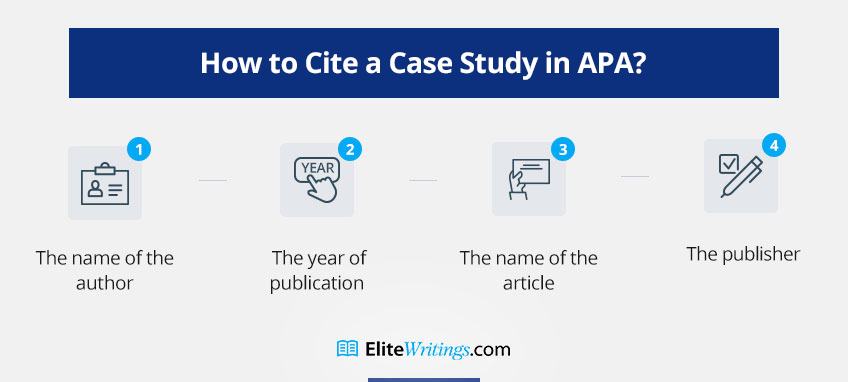
Experts from EliteWritings.com have created a lot of case study APA papers. They got years and years of experience. And now you are reading their explanation in detail on how to write an APA case study. According to them, your paper needs to be double-spaced. According to the case study format APA, your paper will include an abstract, a main body, and a reference list. Also, it should contain a running head on the top left corner of every page. Also, you have to use Arabic numerals for putting in page numbers.
Title Page and Abstract to APA Case Study
In APA, a title page is a separate page that contains only the name of the student, the name of the instructor, the educational institution, and the running head.
An abstract usually contains a few sentences and serves as a summary of the paper. According to the APA guide, an abstract should take 200-250 words. If you do not know how to cite a case study in APA, feel free to find good samples available on the web or address your instructor for assistance.
How to Cite Case Study APA
The best way to cite an APA case study is next: when you quote or paraphrase some text, you need to mention the name of the author and the year of publication. Purdue Online Writing Lab suggests the following quotation:
References in APA Format
All sources used in your case study should appear in your reference list alphabetically. The information from these sources should follow the common order: the name of the article, the date of publication, the title, and the publisher.
A finished entry can look as follows:
Case Study Format APA Examples on EliteWritings.com
- Mary Kay Cosmetics Analysis .
- Feasibility Analysis of the Project .
- Malaysian Airlines Business Turnaround Plan .
- Civil Law Case Analysis Example .
- WalMart Inc. Employees Health Analysis .
Please notice!
Some text in the modal.
How to Write a Case Study - All You Wanted to Know

What do you study in your college? If you are a psychology, sociology, or anthropology student, we bet you might be familiar with what a case study is. This research method is used to study a certain person, group, or situation. In this guide from our dissertation writing service , you will learn how to write a case study professionally, from researching to citing sources properly. Also, we will explore different types of case studies and show you examples — so that you won’t have any other questions left.
What Is a Case Study?
A case study is a subcategory of research design which investigates problems and offers solutions. Case studies can range from academic research studies to corporate promotional tools trying to sell an idea—their scope is quite vast.
What Is the Difference Between a Research Paper and a Case Study?
While research papers turn the reader’s attention to a certain problem, case studies go even further. Case study guidelines require students to pay attention to details, examining issues closely and in-depth using different research methods. For example, case studies may be used to examine court cases if you study Law, or a patient's health history if you study Medicine. Case studies are also used in Marketing, which are thorough, empirically supported analysis of a good or service's performance. Well-designed case studies can be valuable for prospective customers as they can identify and solve the potential customers pain point.
Case studies involve a lot of storytelling – they usually examine particular cases for a person or a group of people. This method of research is very helpful, as it is very practical and can give a lot of hands-on information. Most commonly, the length of the case study is about 500-900 words, which is much less than the length of an average research paper.
The structure of a case study is very similar to storytelling. It has a protagonist or main character, which in your case is actually a problem you are trying to solve. You can use the system of 3 Acts to make it a compelling story. It should have an introduction, rising action, a climax where transformation occurs, falling action, and a solution.
Here is a rough formula for you to use in your case study:
Problem (Act I): > Solution (Act II) > Result (Act III) > Conclusion.
Types of Case Studies
The purpose of a case study is to provide detailed reports on an event, an institution, a place, future customers, or pretty much anything. There are a few common types of case study, but the type depends on the topic. The following are the most common domains where case studies are needed:

- Historical case studies are great to learn from. Historical events have a multitude of source info offering different perspectives. There are always modern parallels where these perspectives can be applied, compared, and thoroughly analyzed.
- Problem-oriented case studies are usually used for solving problems. These are often assigned as theoretical situations where you need to immerse yourself in the situation to examine it. Imagine you’re working for a startup and you’ve just noticed a significant flaw in your product’s design. Before taking it to the senior manager, you want to do a comprehensive study on the issue and provide solutions. On a greater scale, problem-oriented case studies are a vital part of relevant socio-economic discussions.
- Cumulative case studies collect information and offer comparisons. In business, case studies are often used to tell people about the value of a product.
- Critical case studies explore the causes and effects of a certain case.
- Illustrative case studies describe certain events, investigating outcomes and lessons learned.
Need a compelling case study? EssayPro has got you covered. Our experts are ready to provide you with detailed, insightful case studies that capture the essence of real-world scenarios. Elevate your academic work with our professional assistance.

Case Study Format
The case study format is typically made up of eight parts:
- Executive Summary. Explain what you will examine in the case study. Write an overview of the field you’re researching. Make a thesis statement and sum up the results of your observation in a maximum of 2 sentences.
- Background. Provide background information and the most relevant facts. Isolate the issues.
- Case Evaluation. Isolate the sections of the study you want to focus on. In it, explain why something is working or is not working.
- Proposed Solutions. Offer realistic ways to solve what isn’t working or how to improve its current condition. Explain why these solutions work by offering testable evidence.
- Conclusion. Summarize the main points from the case evaluations and proposed solutions. 6. Recommendations. Talk about the strategy that you should choose. Explain why this choice is the most appropriate.
- Implementation. Explain how to put the specific strategies into action.
- References. Provide all the citations.
How to Write a Case Study
Let's discover how to write a case study.

Setting Up the Research
When writing a case study, remember that research should always come first. Reading many different sources and analyzing other points of view will help you come up with more creative solutions. You can also conduct an actual interview to thoroughly investigate the customer story that you'll need for your case study. Including all of the necessary research, writing a case study may take some time. The research process involves doing the following:
- Define your objective. Explain the reason why you’re presenting your subject. Figure out where you will feature your case study; whether it is written, on video, shown as an infographic, streamed as a podcast, etc.
- Determine who will be the right candidate for your case study. Get permission, quotes, and other features that will make your case study effective. Get in touch with your candidate to see if they approve of being part of your work. Study that candidate’s situation and note down what caused it.
- Identify which various consequences could result from the situation. Follow these guidelines on how to start a case study: surf the net to find some general information you might find useful.
- Make a list of credible sources and examine them. Seek out important facts and highlight problems. Always write down your ideas and make sure to brainstorm.
- Focus on several key issues – why they exist, and how they impact your research subject. Think of several unique solutions. Draw from class discussions, readings, and personal experience. When writing a case study, focus on the best solution and explore it in depth. After having all your research in place, writing a case study will be easy. You may first want to check the rubric and criteria of your assignment for the correct case study structure.
Read Also: ' WHAT IS A CREDIBLE SOURCES ?'
Although your instructor might be looking at slightly different criteria, every case study rubric essentially has the same standards. Your professor will want you to exhibit 8 different outcomes:
- Correctly identify the concepts, theories, and practices in the discipline.
- Identify the relevant theories and principles associated with the particular study.
- Evaluate legal and ethical principles and apply them to your decision-making.
- Recognize the global importance and contribution of your case.
- Construct a coherent summary and explanation of the study.
- Demonstrate analytical and critical-thinking skills.
- Explain the interrelationships between the environment and nature.
- Integrate theory and practice of the discipline within the analysis.
Need Case Study DONE FAST?
Pick a topic, tell us your requirements and get your paper on time.
Case Study Outline
Let's look at the structure of an outline based on the issue of the alcoholic addiction of 30 people.
Introduction
- Statement of the issue: Alcoholism is a disease rather than a weakness of character.
- Presentation of the problem: Alcoholism is affecting more than 14 million people in the USA, which makes it the third most common mental illness there.
- Explanation of the terms: In the past, alcoholism was commonly referred to as alcohol dependence or alcohol addiction. Alcoholism is now the more severe stage of this addiction in the disorder spectrum.
- Hypotheses: Drinking in excess can lead to the use of other drugs.
- Importance of your story: How the information you present can help people with their addictions.
- Background of the story: Include an explanation of why you chose this topic.
- Presentation of analysis and data: Describe the criteria for choosing 30 candidates, the structure of the interview, and the outcomes.
- Strong argument 1: ex. X% of candidates dealing with anxiety and depression...
- Strong argument 2: ex. X amount of people started drinking by their mid-teens.
- Strong argument 3: ex. X% of respondents’ parents had issues with alcohol.
- Concluding statement: I have researched if alcoholism is a disease and found out that…
- Recommendations: Ways and actions for preventing alcohol use.
Writing a Case Study Draft
After you’ve done your case study research and written the outline, it’s time to focus on the draft. In a draft, you have to develop and write your case study by using: the data which you collected throughout the research, interviews, and the analysis processes that were undertaken. Follow these rules for the draft:

| 📝 Step | 📌 Description |
|---|---|
| 1. Draft Structure | 🖋️ Your draft should contain at least 4 sections: an introduction; a body where you should include background information, an explanation of why you decided to do this case study, and a presentation of your main findings; a conclusion where you present data; and references. |
| 2. Introduction | 📚 In the introduction, you should set the pace very clearly. You can even raise a question or quote someone you interviewed in the research phase. It must provide adequate background information on the topic. The background may include analyses of previous studies on your topic. Include the aim of your case here as well. Think of it as a thesis statement. The aim must describe the purpose of your work—presenting the issues that you want to tackle. Include background information, such as photos or videos you used when doing the research. |
| 3. Research Process | 🔍 Describe your unique research process, whether it was through interviews, observations, academic journals, etc. The next point includes providing the results of your research. Tell the audience what you found out. Why is this important, and what could be learned from it? Discuss the real implications of the problem and its significance in the world. |
| 4. Quotes and Data | 💬 Include quotes and data (such as findings, percentages, and awards). This will add a personal touch and better credibility to the case you present. Explain what results you find during your interviews in regards to the problem and how it developed. Also, write about solutions which have already been proposed by other people who have already written about this case. |
| 5. Offer Solutions | 💡 At the end of your case study, you should offer possible solutions, but don’t worry about solving them yourself. |
Use Data to Illustrate Key Points in Your Case Study
Even though your case study is a story, it should be based on evidence. Use as much data as possible to illustrate your point. Without the right data, your case study may appear weak and the readers may not be able to relate to your issue as much as they should. Let's see the examples from essay writing service :
With data: Alcoholism is affecting more than 14 million people in the USA, which makes it the third most common mental illness there. Without data: A lot of people suffer from alcoholism in the United States.
Try to include as many credible sources as possible. You may have terms or sources that could be hard for other cultures to understand. If this is the case, you should include them in the appendix or Notes for the Instructor or Professor.
Finalizing the Draft: Checklist
After you finish drafting your case study, polish it up by answering these ‘ask yourself’ questions and think about how to end your case study:
- Check that you follow the correct case study format, also in regards to text formatting.
- Check that your work is consistent with its referencing and citation style.
- Micro-editing — check for grammar and spelling issues.
- Macro-editing — does ‘the big picture’ come across to the reader? Is there enough raw data, such as real-life examples or personal experiences? Have you made your data collection process completely transparent? Does your analysis provide a clear conclusion, allowing for further research and practice?
Problems to avoid:
- Overgeneralization – Do not go into further research that deviates from the main problem.
- Failure to Document Limitations – Just as you have to clearly state the limitations of a general research study, you must describe the specific limitations inherent in the subject of analysis.
- Failure to Extrapolate All Possible Implications – Just as you don't want to over-generalize from your case study findings, you also have to be thorough in the consideration of all possible outcomes or recommendations derived from your findings.
How to Create a Title Page and Cite a Case Study
Let's see how to create an awesome title page.
Your title page depends on the prescribed citation format. The title page should include:
- A title that attracts some attention and describes your study
- The title should have the words “case study” in it
- The title should range between 5-9 words in length
- Your name and contact information
- Your finished paper should be only 500 to 1,500 words in length.With this type of assignment, write effectively and avoid fluff
Here is a template for the APA and MLA format title page:
There are some cases when you need to cite someone else's study in your own one – therefore, you need to master how to cite a case study. A case study is like a research paper when it comes to citations. You can cite it like you cite a book, depending on what style you need.
Citation Example in MLA Hill, Linda, Tarun Khanna, and Emily A. Stecker. HCL Technologies. Boston: Harvard Business Publishing, 2008. Print.
Citation Example in APA Hill, L., Khanna, T., & Stecker, E. A. (2008). HCL Technologies. Boston: Harvard Business Publishing.
Citation Example in Chicago Hill, Linda, Tarun Khanna, and Emily A. Stecker. HCL Technologies.
Case Study Examples
To give you an idea of a professional case study example, we gathered and linked some below.
Eastman Kodak Case Study
Case Study Example: Audi Trains Mexican Autoworkers in Germany
To conclude, a case study is one of the best methods of getting an overview of what happened to a person, a group, or a situation in practice. It allows you to have an in-depth glance at the real-life problems that businesses, healthcare industry, criminal justice, etc. may face. This insight helps us look at such situations in a different light. This is because we see scenarios that we otherwise would not, without necessarily being there. If you need custom essays , try our research paper writing services .
Get Help Form Qualified Writers
Crafting a case study is not easy. You might want to write one of high quality, but you don’t have the time or expertise. If you’re having trouble with your case study, help with essay request - we'll help. EssayPro writers have read and written countless case studies and are experts in endless disciplines. Request essay writing, editing, or proofreading assistance from our custom case study writing service , and all of your worries will be gone.
Don't Know Where to Start?
Crafting a case study is not easy. You might want to write one of high quality, but you don’t have the time or expertise. Request ' write my case study ' assistance from our service.
What Is A Case Study?
How to cite a case study in apa, how to write a case study.

Daniel Parker
is a seasoned educational writer focusing on scholarship guidance, research papers, and various forms of academic essays including reflective and narrative essays. His expertise also extends to detailed case studies. A scholar with a background in English Literature and Education, Daniel’s work on EssayPro blog aims to support students in achieving academic excellence and securing scholarships. His hobbies include reading classic literature and participating in academic forums.

is an expert in nursing and healthcare, with a strong background in history, law, and literature. Holding advanced degrees in nursing and public health, his analytical approach and comprehensive knowledge help students navigate complex topics. On EssayPro blog, Adam provides insightful articles on everything from historical analysis to the intricacies of healthcare policies. In his downtime, he enjoys historical documentaries and volunteering at local clinics.


APA Citation Guide (APA 7th Edition): Case Studies
- Advertisements
- Artificial Intelligence
- Audio Materials
- Books, eBooks, Course Packs, Lab Manuals & Pamphlets
- Business Reports from Library Databases

Case Studies
- Chemical & Physical Properties This link opens in a new window
- Class Notes, Class Recordings, Class Lectures and Presentations
- Creative Commons Licensed Works
- Digital Assignments: Citing Your Sources This link opens in a new window
- Encyclopedias & Dictionaries
- Games & Objects
- GIS Data This link opens in a new window
- Government & Professional Organization Documents
- Images, Infographics, Maps, Charts & Tables
- Indigenous Elders and Knowledge Keepers (Oral Communication)
- Journal Articles
- Legal Resources
- Magazine Articles
- Newspaper Articles
- Personal Communications (including interviews, emails, intranet resources)
- Reference Information from Library Databases
- Religious & Classical (e.g., Ancient Greek, Roman) Works
- Social Media
- Theses & Dissertations
- Translations / Works in Another Language
- Websites (including documents/PDFs posted on websites)
- When Formatting Citation Elements
- When Identifying Citation Elements in Your Source
- When Identifying the Type of Source
- When Information is Missing
- Works Quoted in Another Source (Indirect Sources)
- Quoting vs. Paraphrasing
- Citation Basics
- APA Citation FAQs
- Plagiarism This link opens in a new window
- APA for Faculty This link opens in a new window
- Writing Support This link opens in a new window
Case Study from a Library Database
Case study from a website.
- Case Study from a Book
| . Case Study Number (if given). Database main URL
Berry, A. (2024). . . Harvard Business School Case 822-122.
| |
|
| |
|
|
| . Case study number (if given). URL
Henderson, R. M., Locke, R. M., & Lyddy, C. (2019). . . Case No. ETH33. | |
|
| |
|
|
Case Study from a Print Book or eBook
| (pp. Page Numbers). Publisher.
Green cause-related marketing for social innovation: Helping people to reimagine plastic recycling and sustainability. In M. M. Galan-Ladero, C. Galera-Casquet, & H. M. Alves (Eds.), (pp. 19-30). Springer. | |
|
| |
|
|
- << Previous: Business Reports from Library Databases
- Next: Chemical & Physical Properties >>
- Last Updated: Aug 28, 2024 2:48 PM
- URL: https://library.senecapolytechnic.ca/apa

Generate accurate APA citations for free
- Knowledge Base
- APA Style 6th edition
- APA format for academic papers (6th edition)
APA Format (6th ed.) for Academic Papers and Essays [Template]
Published on November 6, 2020 by Raimo Streefkerk . Revised on September 4, 2023.
In addition to guidelines for APA citations , there are format guidelines for academic papers and essays. They’re widely used by professionals, researchers and students.
Generate accurate APA citations with Scribbr
The most important APA format guidelines in the 6th edition are:
- Use 12 pt Times New Roman
- Set 1 inch page margins
- Apply double line spacing
- Insert a running head on every page
- Indent every new paragraph ½ inch
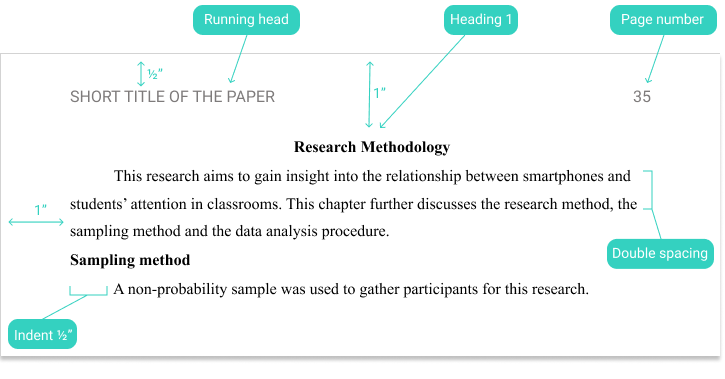
Table of contents
Apa format template, running head, reference page, in-text citations and references, setting up the apa format.
Instead of applying the APA guidelines to your document you can simply download the APA format template for Word.
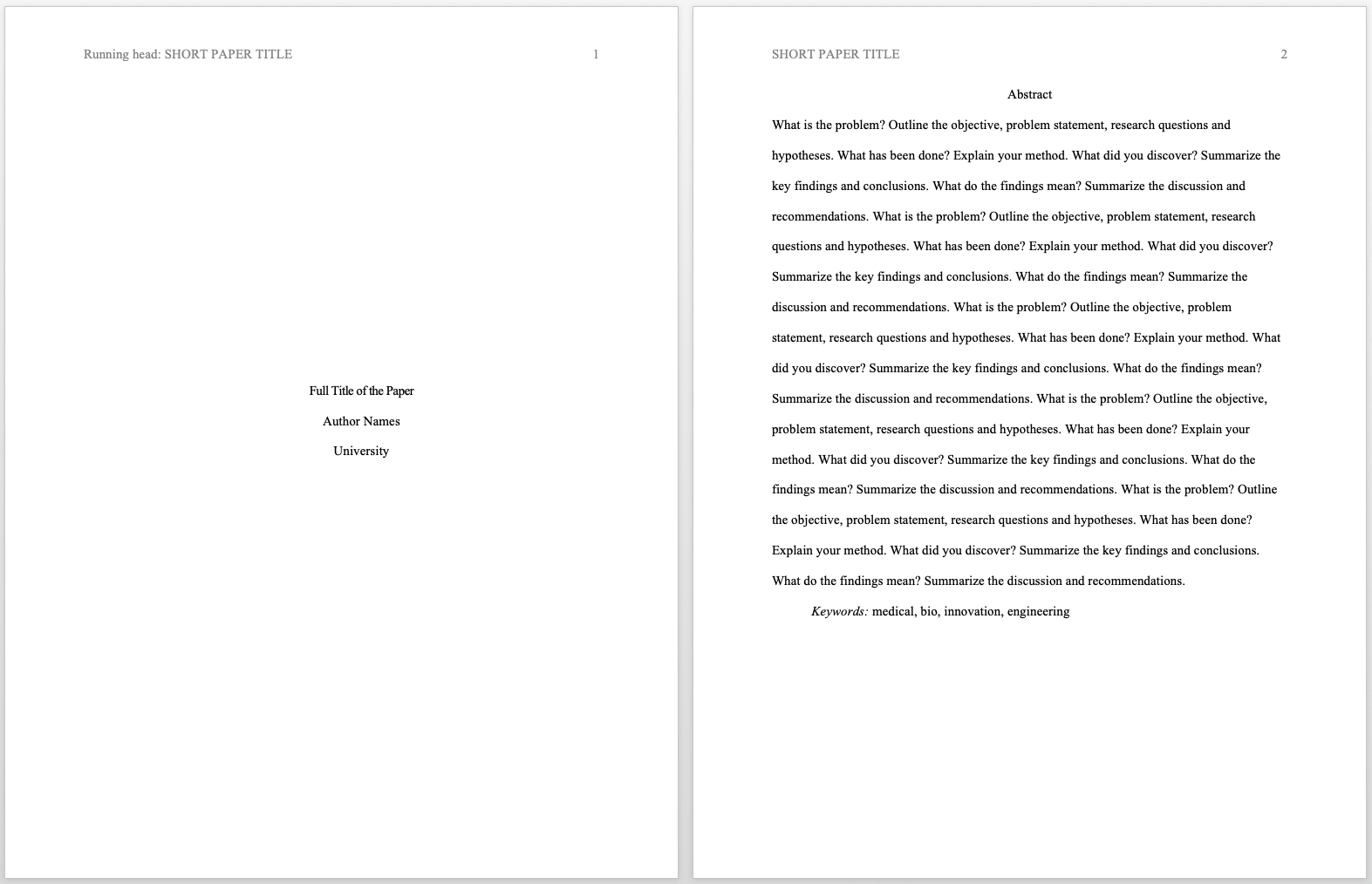
Download APA Format Template (.docx)
Prevent plagiarism. Run a free check.
In the header of each page you include the paper title and page number. If your paper title is longer than 50 characters you should use a shortened version as running head. The page number should be positioned in the top right-hand corner. On the title page the APA running head is preceded by the words “Running head:”.

Throughout your paper you use different heading levels. The levels ranging from one to five help structure the document. Major headings, or heading 1, are used for the titles of chapters such as “Methods” or “Results”. Heading levels two to five are used for subheadings. Each heading level is formatted differently. These are the APA heading guidelines :
| Heading level | APA format |
|---|---|
| Heading 1 | |
| Heading 2 | |
| Heading 3 | The body text begins immediately after the period. |
| Heading 4 | The body text begins immediately after the period. |
| Heading 5 | The body text begins immediately after the point. |
Title case capitalization : Capitalize the first, last, and principal words. Sentence case capitalization : Capitalize only the first word and any proper nouns.
Note that you are not required to include a table of contents in APA style , but if you do choose to include one, all headings should be formatted as plain text, with an additional indent for each level.
The APA title page , also called cover page, is the first page of your paper. The regular formatting guidelines regarding font and margins apply. In addition, an APA formatted title page contains:
- Running head including page number
- Full paper title (in title case)
- Author name(s), without titles and degrees
- Institutional affiliation
Note: APA style has specific guidelines for including more than one author or institutional affiliation on the title page .
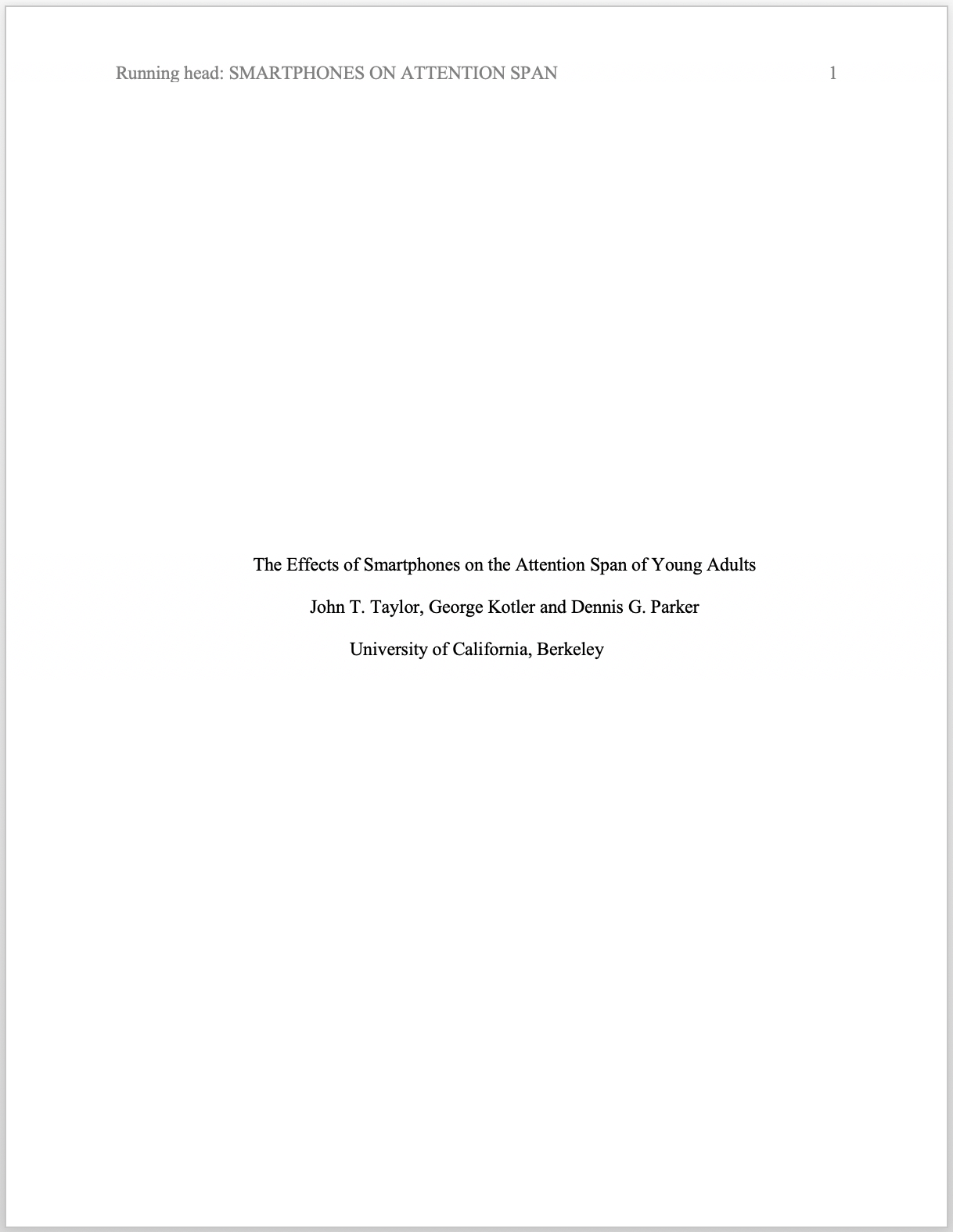
An APA abstract is a one paragraph (± 250 words) summary of your paper. It introduces the objective or problem statement of the paper and includes information on the method, research results, and conclusions of your research. In a separate article we explain in-depth how to write an abstract .
Although most regular APA formatting guidelines apply, the abstract page also has specific requirements. The abstract starts with a centered heading “Abstract”. In contrast to regular APA headings, no styling is applied. The first line of the paragraph is, unlike regular paragraphs, not indented.
At the end of the abstract, keywords relevant to the research are included. These keywords improve the findability of your paper in databases. Indent the line with keywords and start with the italicized word “Keyword:”, followed by the keywords.
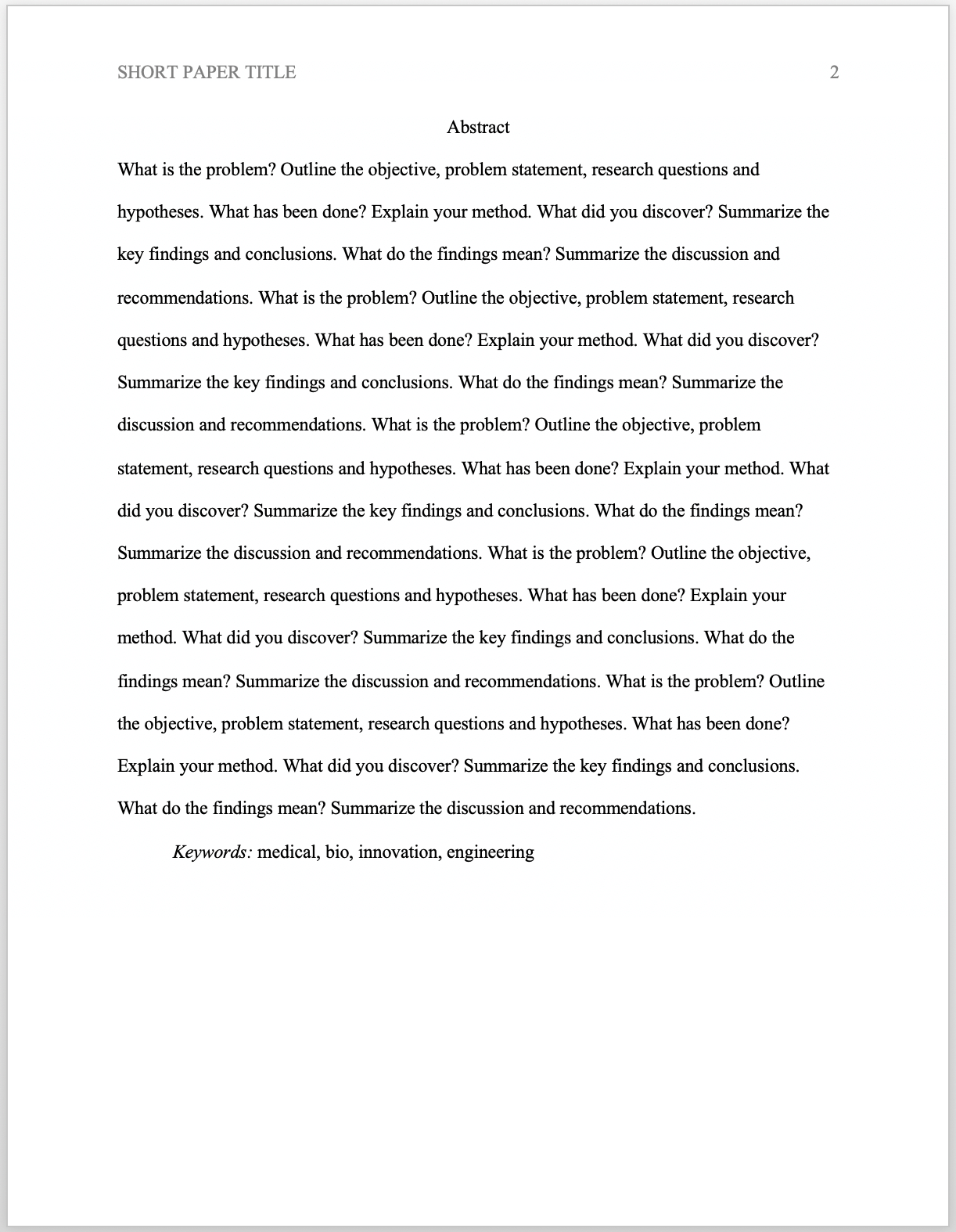
The APA reference page , also called reference list, is where all sources that are cited in the text are listed. The citations differs for each source type. Aside from the references itself the reference page as a whole also has specific APA formatting guidelines.
The APA reference page example below highlights those guidelines regarding page margins, hanging indent and the reference page title “References”. Furthermore, the reference list is sorted alphabetically . You can easily create APA references with Scribbr’s free APA Citation Generator .
APA reference page example
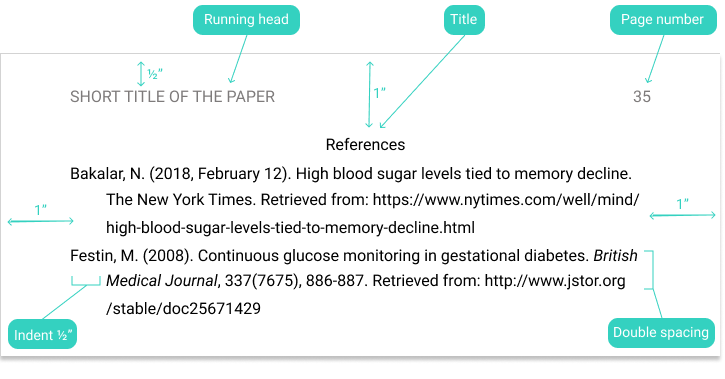
APA format citations consist of parenthetical citation in the text ( APA 6 in-text citations ) and the full reference in the reference list. For each webpage, journal article, book or any other source specific citation guidelines apply.
To make things easier Scribbr created the free APA Citation Generator that cites every source perfectly. Just enter the URL, journal DOI or book ISBN and both the in-text citation and full reference are generated.
In addition, Scribbr has in-depth APA citation examples for every source type ranging from journal articles and books to YouTube videos and tweets .
This video will demonstrate how to set up the APA format in Google Docs.
Cite this Scribbr article
If you want to cite this source, you can copy and paste the citation or click the “Cite this Scribbr article” button to automatically add the citation to our free Citation Generator.
Streefkerk, R. (2023, September 04). APA Format (6th ed.) for Academic Papers and Essays [Template]. Scribbr. Retrieved September 3, 2024, from https://www.scribbr.com/apa-style/6th-edition/archived-format/
Is this article helpful?
Raimo Streefkerk
Scribbr apa citation checker.
An innovative new tool that checks your APA citations with AI software. Say goodbye to inaccurate citations!


APA Style for beginners

Then check out some frequently asked questions:
What is APA Style?
Why use apa style in high school, how do i get started with apa style, what apa style products are available, your help wanted.
APA Style is the most common writing style used in college and career. Its purpose is to promote excellence in communication by helping writers create clear, precise, and inclusive sentences with a straightforward scholarly tone. It addresses areas of writing such as how to
- format a paper so it looks professional;
- credit other people’s words and ideas via citations and references to avoid plagiarism; and
- describe other people with dignity and respect using inclusive, bias-free language.
APA Style is primarily used in the behavioral sciences, which are subjects related to people, such as psychology, education, and nursing. It is also used by students in business, engineering, communications, and other classes. Students use it to write academic essays and research papers in high school and college, and professionals use it to conduct, report, and publish scientific research .
High school students need to learn how to write concisely, precisely, and inclusively so that they are best prepared for college and career. Here are some of the reasons educators have chosen APA Style:
- APA Style is the style of choice for the AP Capstone program, the fastest growing AP course, which requires students to conduct and report independent research.
- APA Style helps students craft written responses on standardized tests such as the SAT and ACT because it teaches students to use a direct and professional tone while avoiding redundancy and flowery language.
- Most college students choose majors that require APA Style or allow APA Style as an option. It can be overwhelming to learn APA Style all at once during the first years of college; starting APA Style instruction in high school sets students up for success.
High school students may also be interested in the TOPSS Competition for High School Psychology Students , an annual competition from the APA Teachers of Psychology in Secondary Schools for high school students to create a short video demonstrating how a psychological topic has the potential to benefit their school and/or local community and improve people’s lives.
Most people are first introduced to APA Style by reading works written in APA Style. The following guides will help with that:
|
|
|
|
| Handout explaining how journal articles are structured and how to become more efficient at reading and understanding them |
|
| Handout exploring the definition and purpose of abstracts and the benefits of reading them, including analysis of a sample abstract |
Many people also write research papers or academic essays in APA Style. The following resources will help with that:
|
|
|
|
| Guidelines for setting up your paper, including the title page, font, and sample papers |
|
| More than 100 reference examples of various types, including articles, books, reports, films, social media, and webpages |
|
| Handout comparing example APA Style and MLA style citations and references for four common reference types (journal articles, books, edited book chapters, and webpages and websites) |
|
| Handout explaining how to understand and avoid plagiarism |
|
| Checklist to help students write simple student papers (typically containing a title page, text, and references) in APA Style |
|
| Handout summarizing APA’s guidance on using inclusive language to describe people with dignity and respect, with resources for further study |
|
| Free tutorial providing an overview of all areas of APA Style, including paper format, grammar and usage, bias-free language, punctuation, lists, italics, capitalization, spelling, abbreviations, number use, tables and figures, and references |
|
| Handout covering three starter areas of APA Style: paper format, references and citations, and inclusive language |
Instructors will also benefit from using the following APA Style resources:
|
|
|
|
| Recording of a webinar conducted in October 2023 to refresh educators’ understanding of the basics of APA Style, help them avoid outdated APA Style guidelines (“zombie guidelines”), debunk APA Style myths (“ghost guidelines”), and help students learn APA Style with authoritative resources |
|
| Recording of a webinar conducted in May 2023 to help educators understand how to prepare high school students to use APA Style, including the relevance of APA Style to high school and how students’ existing knowledge MLA style can help ease the transition to APA Style (register for the webinar to receive a link to the recording) |
|
| Recording of a webinar conducted in September 2023 to help English teachers supplement their own APA Style knowledge, including practical getting-started tips to increase instructor confidence, the benefits of introducing APA Style in high school and college composition classes, some differences between MLA and APA Style, and resources to prepare students for their future in academic writing |
|
| Poster showing the three main principles of APA Style: clarity, precision, and inclusion |
|
| A 30-question activity to help students practice using the APA Style manual and/or APA Style website to look up answers to common questions |
In addition to all the free resources on this website, APA publishes several products that provide comprehensive information about APA Style:
|
|
|
|
| The official APA Style resource for students, covering everything students need to know to write in APA Style |
|
| The official source for APA Style, containing everything in the plus information relevant to conducting, reporting, and publishing psychological research |
|
| APA Style’s all-digital workbook with interactive questions and graded quizzes to help you learn and apply the basic principles of APA Style and scholarly writing; integrates with popular learning management systems, allowing educators to track and understand student progress |
|
| APA’s online learning platform with interactive lessons about APA Style and academic writing, reference management, and tools to create and format APA Style papers |
The APA Style team is interested in developing additional resources appropriate for a beginner audience. If you have resources you would like to share, or feedback on this topic, please contact the APA Style team .
Free newsletter
Apa style monthly.
Subscribe to the APA Style Monthly newsletter to get tips, updates, and resources delivered directly to your inbox.
Welcome! Thank you for subscribing.

- Free Case Studies
- Business Essays
Write My Case Study
Buy Case Study
Case Study Help
- Case Study For Sale
- Case Study Services
- Hire Writer
APA Format Case Study
APA is used to conduct a research in social sciences. It is one of the most popular formats to follow, and it is obligatory to use it in writing a major number of students’ papers in many universities. Students are taught to write a case study format APA since it is also used for a scientific research.
How to Write a Case Study Paper in APA
Case study format APA means following the proper formatting style, but all other requirements for conducting a research still the same.
Start from choosing a topic. It is very positive if it is not set by circumstances, but in interesting for a researcher himself. This will affect the work itself in a positive way. If an author is interested in writing on this topic, then it will be interesting for others to read it.The next step is to decide on the amount of work that one is going to write. If there is a lot of material, then maybe it makes sense to make the topic narrower or re-qualify the scientific work in the thesis.
APA case study needs a well-developed plan. Writing a plan will help to organize the events that one want to tell the scientific community, his thoughts on this matter and the conclusions that he makes on their basis. Consider in the plan of scientific work that in the first part of it a task should be set and the state of affairs in the area that one intends to investigate should be mentioned. Then the experiments conducted should be described, and observations should be noted. In the end, the observations are analyzed, and conclusions are drawn.
What Format to Follow
General APA case study format includes a title page, an abstract, body pages, conclusion and reference list.
It also may contain appendixes if the research is large and requires using charts, graphs, and interviews.A title page should include the name of an author, the topic of his work, the name of the university or other organization where research was conducted and a running head. Running head is a brief statement (up to three words) that reveals the main idea the investigation is made on. It should be used on all of the pages of the paper. It should be typed in capital letters on all pages excluding a title page.An abstract is a brief summary, and it emphasizes the main theme of the paper, goals of a researcher, chosen methods, and obtained results.
An abstract as a rule ends with a set of keywords that characterize the paper. This is made in order that a scientific work will be easy to find in online and offline databases.The introduction should consist consistently of the following parts: the rationale for the topic, its relevance. The relevance of the topic is an explanation of why it is appropriate to address this topic right now, what is the scientific and practical necessity, in what state are current scientific ideas about the subject of research. The justification of the relevance of the topic should be followed by consideration of the degree of scientific elaboration of the problem. Here it is necessary to list the past and current researchers who dealt with this problem in different angles, indicate insufficiently illuminated items.
After considering the degree of scientific development of the problem, a smooth, logical transition to the research goal is carried out.The purpose of the research is its ultimate desired result, the solution of the scientific problem, which in the end should come. The objectives of the study are ways to achieve the goal. The formulation of research tasks is necessary to specify the research objectives. Tasks can be aimed at identifying, analyzing, summarizing, substantiating, developing, individual components of a common problem. It should be remembered that the enumeration of tasks sets the plan and internal logic of the text of the whole work.
An introduction should end with a thesis. The thesis should be argued using reliable sources, supporting and opposing opinions of other authors, real cases from practice and personal experience. The number of these arguments will depend on the volume of case study APA .
What Sources to Use and How to Cite Them
When a person is obliged to write a case study APA format , he is free to choose various sources for the research. They may include books, articles in periodicals, reliable online sources, movies, videos, interviews and scientific works of other authors.
The main requirement is that these sources should not be outdated since, in the case of use materials that are no relevant at the time of research, there is a risk to obtain wrong results. Citing a case study APA is an obligatory requirement in making of the reliable research. It is not obligatory to cite another work directly; sometimes it is allowed to paraphrase; however, the source of paraphrasing should also be mentioned. If it is a direct citing, it is enough to mention the surname of an author/authors, year of publication and page where this citation was initially written. When one cites a movie or a video, it is necessary to record at what minute of a track some words were said.
The bibliography should also be formatted correctly. Every used source should be mentioned in the following order: a name and a surname of an author, year of publication, the title of work, the name of publishing house or organization if it is a periodical, and a number of cited page/pages.
Related posts:
- Short Essay about Reflection
- Handout Proper Case Study Format
- Case Study: Definition, How to Write, Format and Examples
- PAP format Case Study
- Case Study Format
- Format of Case Study
- Format For Case Study Assignment
Quick Links
Privacy Policy
Terms and Conditions
Testimonials
Our Services
Case Study Writing Services
Case Studies For Sale
Our Company
Welcome to the world of case studies that can bring you high grades! Here, at ACaseStudy.com, we deliver professionally written papers, and the best grades for you from your professors are guaranteed!
[email protected] 804-506-0782 350 5th Ave, New York, NY 10118, USA
Acasestudy.com © 2007-2019 All rights reserved.

Hi! I'm Anna
Would you like to get a custom case study? How about receiving a customized one?
Haven't Found The Case Study You Want?
For Only $13.90/page
Home / Guides / Citation Guides / How to Cite Sources / How to Cite a Case Study in APA, MLA, or Chicago
How to Cite a Case Study in APA, MLA, or Chicago
When citing a case study, the format in MLA and APA is similar to that of a report, and in Chicago style, it is similar to that of a book. For all three citation styles, you will need the name of the author(s), the title of the case study, the year it was published, the publishing organization/publisher, and URL (if applicable). The templates and examples below will demonstrate how to cite a case study in MLA, APA, and Chicago styles.
Author Last Name, Author First Name. Title of Case Study . Edition (if applicable), volume number (if applicable), Publisher, year of publication, URL without http:// or https:// (if applicable).
Hill, Linda A., et al. HCL Technologies (A). Rev. edition, Harvard Business School, 2008, www.hbs.edu/faculty/Pages/item.aspx?num=34784.
In-text Citation:
(Author Last Name(s) page #)
(Hill et al. 8)
Author Last Name, Author Initial. (Publication Year). Title of Case Study (Case # if applicable). Publishing Organization. URL
Hill, L., Khanna, T., & Stecker, E. (2008). HCL Technologies (A) (Case 408-004). Harvard Business School. https://www.hbs.edu/faculty/Pages/item.aspx?num=34784
(Author Last Name, Publication Year)
(Hill et al., 2008)
Notes-bibliography style
Author Last Name, First Name. Title of the Case Study . Publishing City: Publishing Organization, Publication Year. URL.
Hill, Linda A., Tarun Khanna, and Emily Stecker. HCL Technologies (A). Boston: Harvard Business School, 2008. https://www.hbs.edu/faculty/Pages/item.aspx?num=34784.
1. Author First Name Last Name, Title of the Case Study (Publishing City: Publishing Organization, Publication Year), URL.
1. Linda A. Hill, Tarun Khanna, and Emily Stecker, HCL Technologies (A) ( Boston: Harvard Business School, 2008), https://www.hbs.edu/faculty/Pages/item.aspx?num=34784.
Author-date style
Author Last Name, First Name. Publication Year. Title of the Case Study . Publishing City: Publishing Organization. URL.
Hill, Linda A., Tarun Khanna, and Emily Stecker. 2008. HCL Technologies (A). Boston: Harvard Business School. https://www.hbs.edu/faculty/Pages/item.aspx?num=34784.
In-text citation:
(Author Last Name Publication Date)
(Holl, Khanna, and Stecker 2008)
Citation Guides
- Annotated Bibliography
- Block Quotes
- Citation Examples
- et al Usage
- In-text Citations
- Page Numbers
- Reference Page
- Sample Paper
- APA 7 Updates
- View APA Guide
- Bibliography
- Works Cited
- MLA 8 Updates
- View MLA Guide
How useful was this post?
Click on a star to rate it!
We are sorry that this post was not useful for you!
Let us improve this post!
Tell us how we can improve this post?
Citation Basics
Harvard Referencing
Plagiarism Basics
Plagiarism Checker
Upload a paper to check for plagiarism against billions of sources and get advanced writing suggestions for clarity and style.
Get Started

Evidence-Based Case Study
Parallel in purpose to the Practice Review articles, I would like to issue an open invitation for authors to submit an Evidence-Based Case Study for possible publication in Psychotherapy . I believe developing such a series of Evidence-Based Case Studies will be extremely useful in several ways.
First, such investigation will provide much needed information to bridge the gap between research and practice.
Second, such studies will provide important templates of how to integrate basic research into applied work at the individual case level. In addition, I hope to open an avenue for publication to those in full time private practice who are interested in integrating research measures into their clinical work.
Finally, I wish to provide a readily identifiable aggregate of systematic case studies from various forms of treatment that meet the American Psychological Association's criteria for Evidence-Based Practice (APA, 2006) as well as the Clinical Utility dimension in the Criteria for Evaluating Treatment Guidelines (APA, 2002).
The goal of these Evidenced-Based Case Studies will be to integrate verbatim clinical case material with standardized measures of process and outcome evaluated at different times across treatment. That is, authors should describe clinical vignettes highlighting key interventions and mechanisms of change regarding their specific approach to treatment in the context of empirical scales.
With this goal in mind I offer the following guidelines for those who are interested in preparing an Evidence-Based Case Study :
1. At minimum the report should include the assessment (from patient or independent rater perspective, not therapist) of at least two standardized outcome measures, global functioning and target symptom (i.e. depression, anxiety, etc), as well as one process measure (i.e. therapeutic alliance, session depth, emotional experiencing, etc) evaluated on at least three separate occasions.
Optimally, such a report would include several outcome measures assessing a wide array of functioning such as global functioning, target symptoms (i.e. depression, anxiety, etc), subjective well-being, interpersonal functioning, social/occupational functioning and measures of personality, as well as relevant process measures evaluated at multiple times across treatment.
2. At minimum, specific outcome data should be presented using standardized mean difference (i.e. effect size) and clinical significance methodology (i.e. unchanged, reliable change, movement into functional distribution, clinically significant change, and deterioration; see Jacobson et al., 1999). Submission of both successful and unsuccessful treatment cases are encouraged. In addition, it might be quite instructive to compare and contrast the technical interventions that occurred during a positive change case with that of a clinically unchanged or deteriorated case from the same approach to treatment.
3. Verbatim clinical vignettes with several patient and therapist turns highlighting key interventions and mechanisms of change regarding the specific approach to treatment should be provided. Discussion of therapeutic interventions should not be presented from a global or abstract perspective.
4. Appropriate informed consent must be obtained.
A good template for this suggested Evidence-Based Case Study format can be found in Hill and colleagues (2008). Other case studies provide a good template for some aspects of this Evidence-Based Case Study format.
Related case studies that effectively address the first two outcome assessment criteria, but lack extensive verbatim clinical vignettes include Borckardt et al., 2008; Jones et al., 1993; and Porcerelli et al., 2007.
Similarly, Busch et al., 2009 report extensive process evaluations over multiple assessments, but do not provide extended verbatim clinical vignettes.
Conversely, Hilsenroth and Slavin, 2008 provide extensive verbatim clinical vignettes of proposed mechanisms of change in the context of summary information on clinically significant change, but do not report specific process or outcome scores.
Finally, Strupp et al., 1992 provide extensive verbatim clinical vignettes from a failed treatment that are quite instructive regarding possible indicators of treatment termination, with initial scores on several assessment measures.
In addition, I do not mean to suggest that this Evidence-Based Case Study section is for advanced statistical time series analyses of process or outcome data, although such articles would certainly be welcomed. Simple analyses of standardized outcome measures by way of clinical significance and effect size methods are sufficient, all of which can be readily tabulated by hand or with a calculator.
Any authors who have conducted an effectiveness or efficacy trial on a particular type of treatment that have collected standardized process and outcome measures across treatment in addition to the use of audio/videotape of sessions should consider submitting an Evidence-Based Case Study . Likewise, any clinician in private practice who would like to add these elements at the initiation of a new case should also consider submitting to this special series.
Anyone who may have an interest in submitting an Evidence-Based Case Study is invited to contact me if they have any questions about this process.
- American Psychological Association, (2002). Criteria for evaluating treatment guidelines. American Psychologist, 57 , 1052–1059.
- American Psychological Association, (2006). Evidence-based practice in psychology. American Psychologist, 61 , 271–285.
- Borckardt, J., Nash, M., Murphy, M., Moore, M., Shaw, D., & O'Neil, P. (2008). Clinical practice as a natural laboratory for psychotherapy research. American Psychologist, 63 , 77–95.
- Busch, A., Kanter, J., Callaghan, G., Baruch, D., Weeks, C., & Berlin, K. (2009). A micro-process analysis of functional analytic psychotherapy's mechanism of change. Behavior Therapy, 40 , 280–290.
- Hill, C., Sim, W., Spangler, P., Stahl, J., Sullivan, C., & Teyber, E. (2008). Therapist immediacy in brief psychotherapy: Case study II. Psychotherapy: Theory, Research, Practice, Training, 45 , 298–315.
- Hilsenroth, M., & Slavin, J. (2008). Integrative dynamic treatment for co-morbid depression and borderline conditions. Journal of Psychotherapy Integration , 18 , 377–409.
- Jacobson, N., Roberts, L., Berns, S., & McGlinchey, J. (1999). Methods for defining and determining the clinical significance of treatment effects: Description, application, and alternatives. Journal of Consulting and Clinical Psychology, 67 , 300–307.
- Jones, E., Ghannam, J., Nigg, J & Dyer, J. (1993). A paradigm for single-case research: The time series study of a long-term therapy for depression. Journal of Consulting and Clinical Psychology, 61 , 381–394.
- Porcerelli, J., Dauphin, V., Ablon, J., Leitman, S., & Bambery, M. (2007). Psychoanalysis with avoidant personality disorder: A systematic case study. Psychotherapy: Theory, Research, Practice, Training, 44 , 1–13.
- Strupp, Schacht, Henry, & Binder (1992). Jack M.: A case of premature termination. Psychotherapy: Theory, Research, Practice, Training, 29 , 191–205.
More about this journal
- Psychotherapy
- Pricing and subscription info
- Read sample articles
- Author and reviewer resources
- Call for papers: Spiritual and religious competence in psychotherapy training
Contact Journals

How to Write a Case Study: A Complete Guide with Templates

Writing compelling and insightful case studies is a marketer’s biggest job, yet most get frustrated with this content. The challenge? Figuring out how to write a case study that not only highlights the company’s strongest suit but engages new clients with strategic information. If you often struggle with making case studies as more than just dry facts and figures, you’re leading your efforts to missed opportunities.
How to Write a Case Study Step-by-Step
- Craft a Compelling Headline: Highlight the main success with a clear, direct title.
- Start with a Strong Introduction: Provide a broad overview and hook the reader.
- Discuss Unique Client Challenges: Highlight specific industry-related challenges.
- Highlight the Solution: Showcase your strategies and key results.
- Present Quantifiable Results: Use data and visuals to demonstrate impact.
- Be Clear and Concise: Stick to the point and support claims with data.
- Treat Your Case Study Like a Story: Focus on the customer’s journey and success.
- Use Direct Quotes from the Client: Add authenticity with client testimonials.
- Make the Key Takeaway Clear: Reinforce your expertise and the solution’s value.
- Include a Call to Action (CTA): Guide the reader on what to do next.
- Make It Readable: Use simple language, short paragraphs, and bullet points.
- Finalize and Proofread: Review for errors and ensure a smooth flow.
In this blog, you’ll discover a step-by-step guide that simplifies the process, making it easier to create interesting case studies. From planning to writing, I’ve got you covered. So, let’s start with some basics.
Table of Contents
What is the format of a case study.
- How to Plan a Case Study
How to Write a Case Study
How to summarize a case study, how to cite a case study.
A well-structured case study isn’t just a collection of facts—it’s a powerful marketing tool that tells a compelling story. Using the right format for a case study ensures that your message is clear, engaging, and impactful.
The proper format guides readers through the narrative with hierarchy and scannability, helping them connect with your brand on a deeper level. Most importantly, it empowers you as a marketer to set clear goals for presenting your case studies and ensures you deliver the correct information effectively!
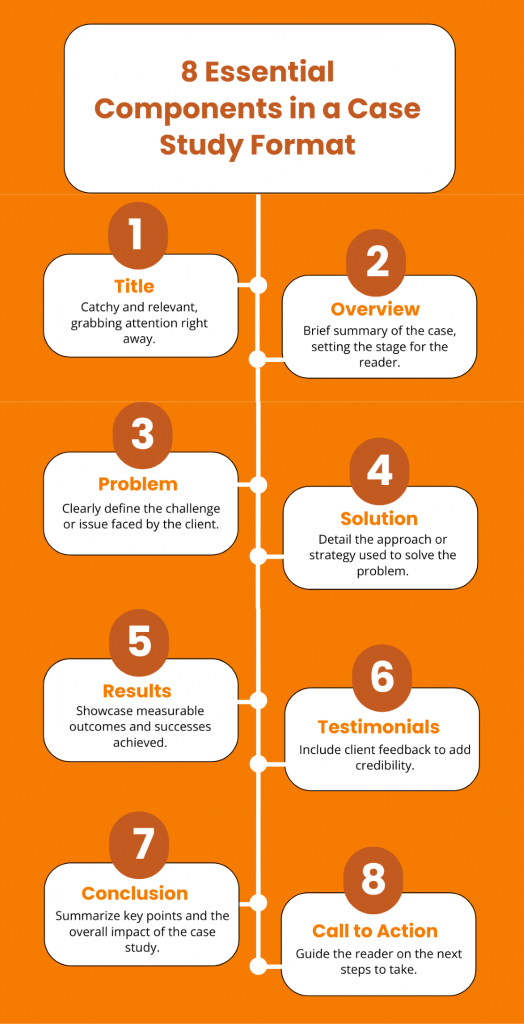
Case studies format helps you to plan and write the case study for your clients. With this outline in mind, you can create steps to complete the process of writing and publishing your case study research. There are eight components of a case study that are essential for building a layout of information in the correct order that makes sense to the viewers.
Start with a catchy “Title” that grabs attention and an “Overview” that sets the stage. Clearly define the “Problem” your client faced, and then showcase your “Solution” in detail. Highlight the success with “Results” that are measurable and impactful. Add authenticity with “Testimonials and Quotes” from satisfied clients. Wrap it up with a firm “Conclusion” and a compelling “Call to Action” in the “About Us” section that guides the reader on what to do next.
By following this format, you create a case study design that resonates with your audience and effectively showcases your brand’s value.
Check out the marketing case study template I’ve included below—it has a clear outline that makes it easy to see how sticking to a format can help you plan and write the entire thing.

How to Plan a Case Study
Now comes the big part! Understanding what to include in a case study outline is just the starting point for beginners. The real challenge lies in creating a step-by-step plan to craft that outline and filling it in with the right information!

1. Set Clear Goals for Your Case Study
Before diving into how to write a case study, defining your ultimate objective is essential. Think about it—what do you want your audience to take away from this case study? For example, your goal is to showcase how your SEO strategies boosted a client’s organic traffic by 150% in just six months. This clear goal will shape your entire narrative and ensure that your case study is laser-focused on demonstrating your expertise and the value you bring.
2. Select a Client that Highlights Your Strongest Suit
Choosing the right client or subject is vital while creating case studies. Imagine you’ve worked with a small e-commerce brand struggling to rank for competitive keywords. Your strategies helped them rank on the first page and increase conversions. This is the perfect client for your case study because their success story directly showcases your SEO prowess.
By picking a client whose experience aligns with your goals, you’ll create a case study that resonates with your target audience.
3. Reach Out to Your Client for Collaboration
Now that you’ve identified the ideal client, it’s time to reach out. Let’s say you contact your client and explain how a case study can highlight their remarkable success story. It’s a great way to spotlight a mutual collaboration based on credibility. Their buy-in is crucial; their insights and data will authenticate your case study.
4. Gather Comprehensive Data and Insights
Data is the lifeblood of any compelling case study. For instance, in your SEO case study, you’ll need to gather data on key metrics like keyword rankings, organic traffic, and conversion rates before and after implementing your strategies. Let’s say your client saw a 50% increase in organic traffic within three months of optimizing their website. Collecting this data will help you build a robust, evidence-based narrative highlighting your impact.
It’s essential to monitor the before-and-after data to track the effectiveness of implementing your strategies.
5. Prepare Insightful Questions and Conduct Interviews
It would be best to ask the right questions to get the most out of your client interviews. Imagine asking your client, “What specific challenges were you facing with your organic search rankings before we started working together?” or “How did our SEO strategies help you achieve your business goals?” These questions will lead to detailed responses that add depth to your case study, making it more than just numbers on a page.
Always ask questions that uncover the key challenges your clients face. This way, your prospects will know when to turn to you to navigate or overcome similar obstacles in their business.
Since I’m giving an example of an SEO case study in marketing, you can try these questions to interview your existing client. Obviously, you can modify the sentences according to your industry basics, but these types of questions are fundamental for collecting structured data from your clients.
- What were your business’s main SEO challenges before we started working together?
- Can you describe your initial expectations for implementing our SEO strategies?
- What specific SEO tactics did we implement that you found most effective?
- How did you monitor and measure the impact of these strategies on your organic traffic?
- What were the key metrics or results that stood out to you after the first three months?
6. Ask Questions That Drive the Story Forward
Impactful questions are the backbone of a strong case study. They allow you to highlight the unique value you delivered to your clients. You can effortlessly showcase your USPs within the case study by asking the right questions.
Focus on inquiring about the effectiveness of your services and strategies, their impact, and which aspects of the solution were most beneficial. This insight will be your key to demonstrating the tangible benefits you offer your clients.
Consider asking questions like:
- Can you share a moment when you first noticed a significant improvement in your website’s organic traffic?
- How did the increase in organic traffic impact other business areas, such as lead generation or sales?
- What feedback did your team or customers receive regarding the changes in your site’s performance?
- Looking back, what do you believe was the most critical factor in achieving these results?
- How has this success with SEO influenced your overall marketing strategy moving forward?
These types of questions encourage clients to share their experiences in a way that paints a vivid picture for your readers, making the case study more relatable and engaging.
7. Draft a Clear and Organized Outline
With all the data and insights gathered, it’s time to create a well-structured case study outline. Let’s say you start with a brief overview of your client’s business and its challenges, followed by a detailed account of the SEO strategies you implemented. Then, you showcase the results with hard data and close with client testimonials and a solid call to action.
As mentioned above, organizing your content in a logical, easy-to-follow format will help you write a case study that not only informs but also captivates your audience.
These steps are the cornerstones of designing a case study. Once you complete this checklist, you can proceed to the next step, which is writing a case study. Since I discussed planning an SEO case study extensively, here is a case study template that perfectly illustrates the process.

You want to create an informative case study for your prospects. But how do you make sure it’s done right? Here’s a step-by-step guide on how to write a case study that drives results.
1. Craft a Compelling Headline
Your headline is the first thing readers see, so make it count! It should grab attention and hint at the success story you’re about to share.
How to Write a Case Study Title:
1. Highlight the Result: Showcase the critical success, like “Increased Sales by 200%.”
2. Be Clear and Direct: Make sure the headline is straightforward to grasp.
3. Use Action Words: Start with strong verbs like “How We” or “Achieved.”
4. Mention Client or Industry: Include relevant details for specificity.
5. Keep It Short: Make it concise and attention-grabbing.
2. Start with a Strong Introduction
Kick off your case study with a broad overview that sets the stage. Provide the big picture and construct a clear narrative that draws readers in, making them eager to learn more about how you solved a significant challenge.
Look at the consulting case study template , which includes a stunning overview description and precise instructions for writing a short and compelling introduction. You can add every little detail to hook the reader.

Get This Template and More
3. Discuss Specific Challenges of Your Client
This is where your prospect can truly connect. By highlighting unique yet specific challenges to their industry, you give them insight into issues they might not have encountered yet—or ones they’ve already faced. This way, they’ll know exactly who to turn to when similar challenges arise.
The following financial case study template provides a brief flow of the company’s common challenges in the financial analysis process. The template is almost ready to use with this domain-specific content, requiring minimal adjustments to design your case study.
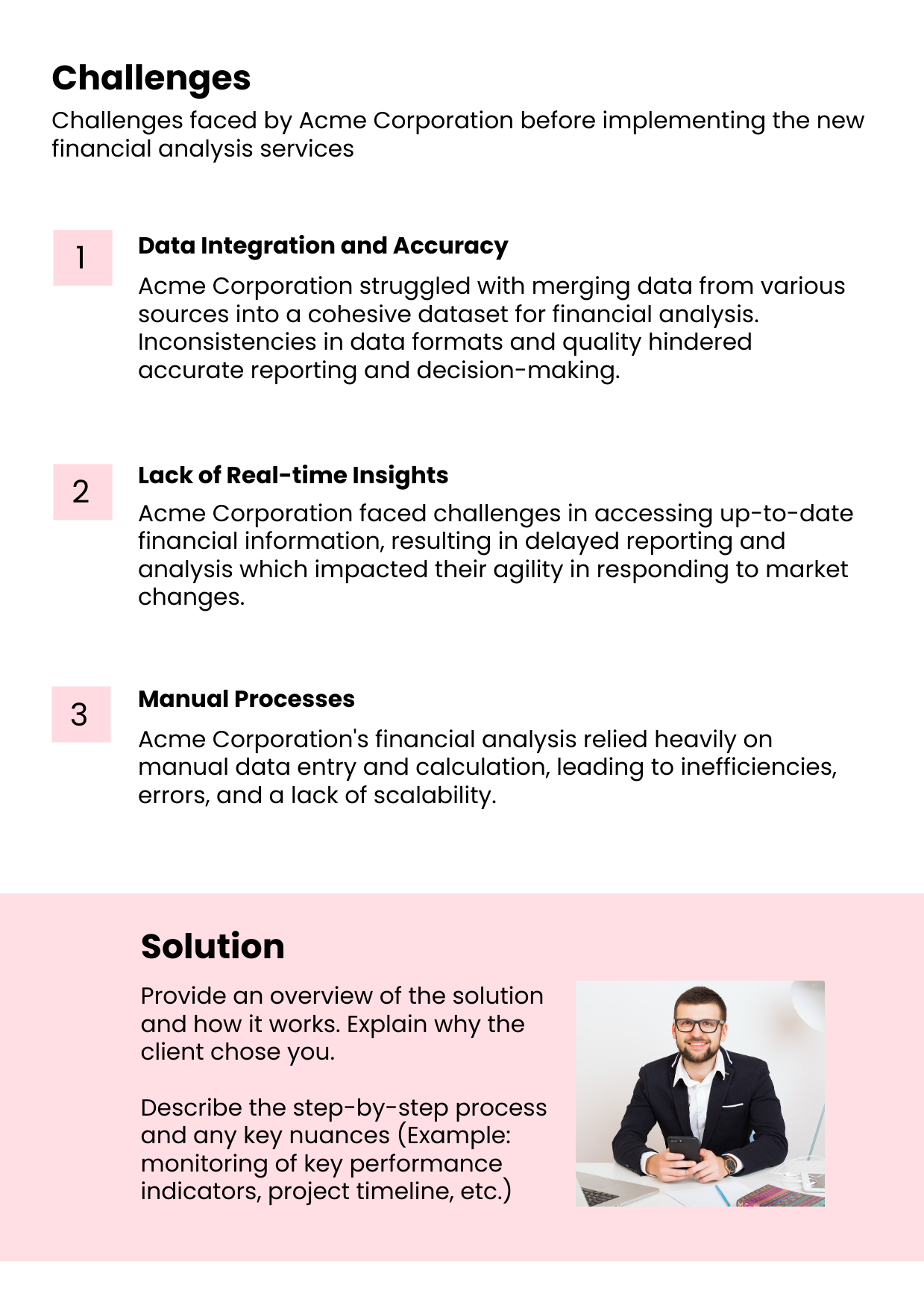
4. Highlight the Solution
Now, dive into the heart of the story. Highlight the solution you provided, and make sure to include a notable achievement or key result. This is your chance to shine!
Check out the format for presenting the implications of your service on your client’s business. The benefits should be well-written and data-driven to convince your upcoming clients. This graphic design case study format helps you understand the specific impacts a company seeks from a reputable graphic design firm.
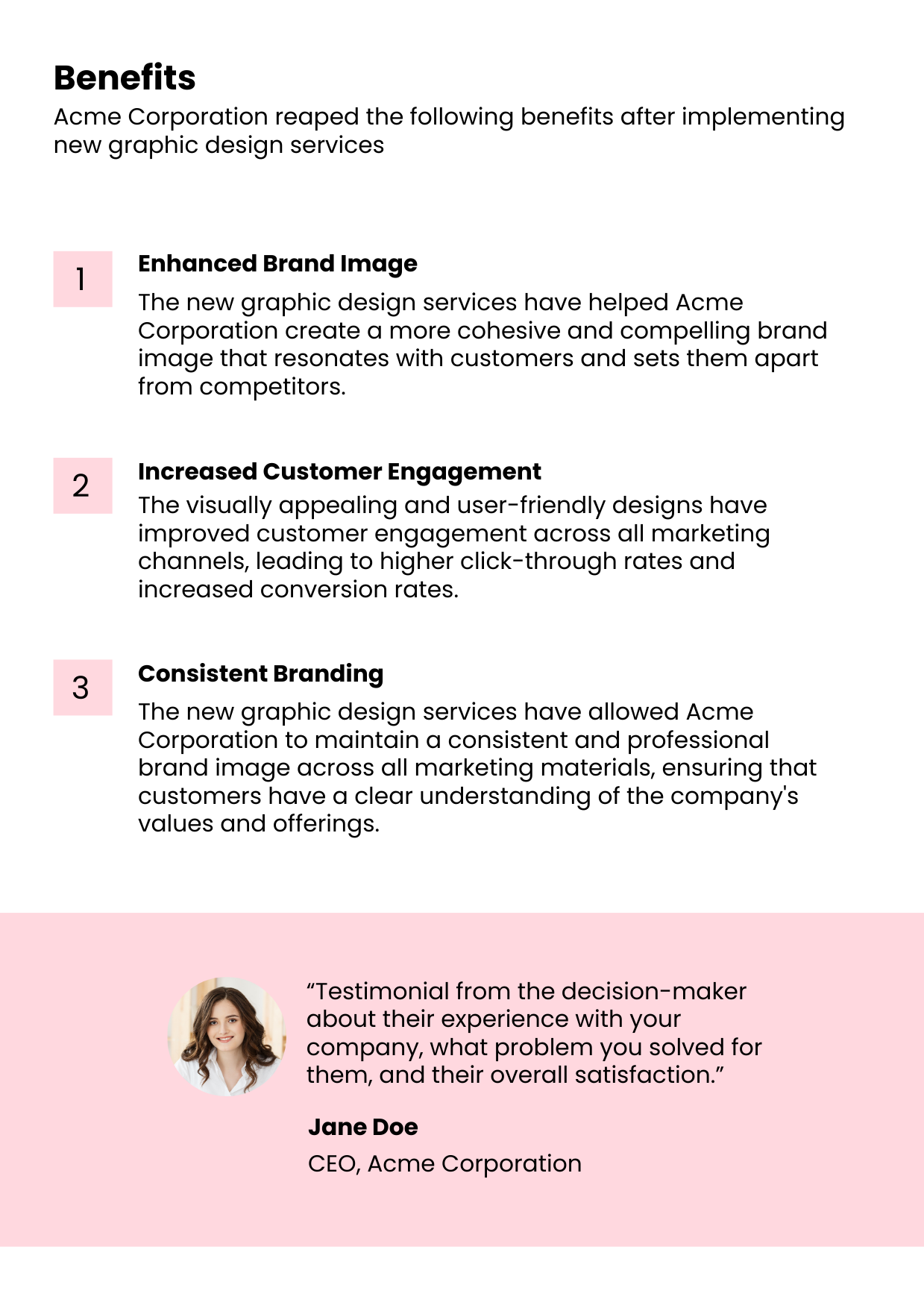
5. Present Quantifiable Results
When sharing the outcome, numbers speak louder than words. Present quantifiable results that clearly demonstrate the impact of your solution. Use graphs or charts to make the data easy to digest and visually appealing.
6. Be Clear and Concise
Less is more. Stick to the point and offer just the right amount of detail to keep your readers engaged. Include data that supports your claims, but avoid overwhelming them with too much information.
Here’s a stunning sales consulting case study that uses a simple case study layout and details written in readable, plain language to gauge more utility.

7. Treat Your Case Study Like a Story
Focus on your customer’s journey. Think of your case study as a story in which your client is the hero, and your solution is the tool that helped them succeed. This approach will make your case study relatable and compelling.
8. Be as Specific as Possible
Don’t be vague—details matter. Mention the specific company and its industry to let your audience know that the challenge and solution are relevant to them. The more precise you are, the more credible and trustworthy your case study will be.
Check out the sample case study below for payroll accounting. The details are clearly organized and grouped to emphasize the type of case study.

Also, the next case study template displays very specific problems that a company faces when it lacks digital marketing expertise.
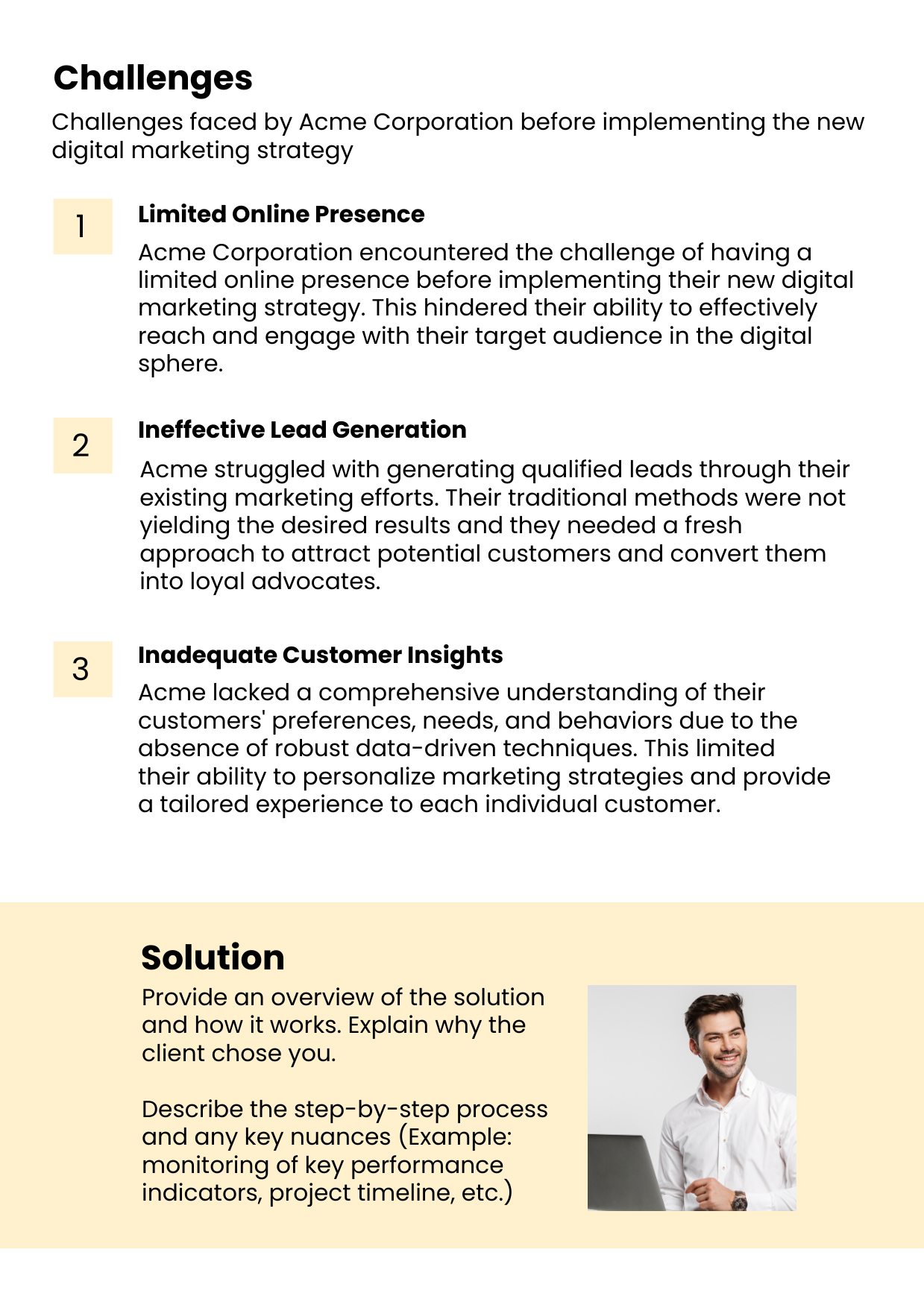
These templates make it a breeze to craft a case study that’s perfect for your niche.
9. Use Direct Quotes from the Client
Quotes from your client add authenticity and credibility. They give readers insight into the client’s perspective and make your case study more relatable. Plus, a glowing testimonial is always a nice touch!
The following inbound marketing case study has a prominent client testimonial. With the brief instructions on this template, it’s easier for you to understand how to capture the golden words of your client and use them as a word-of-mouth strategy within the case study.
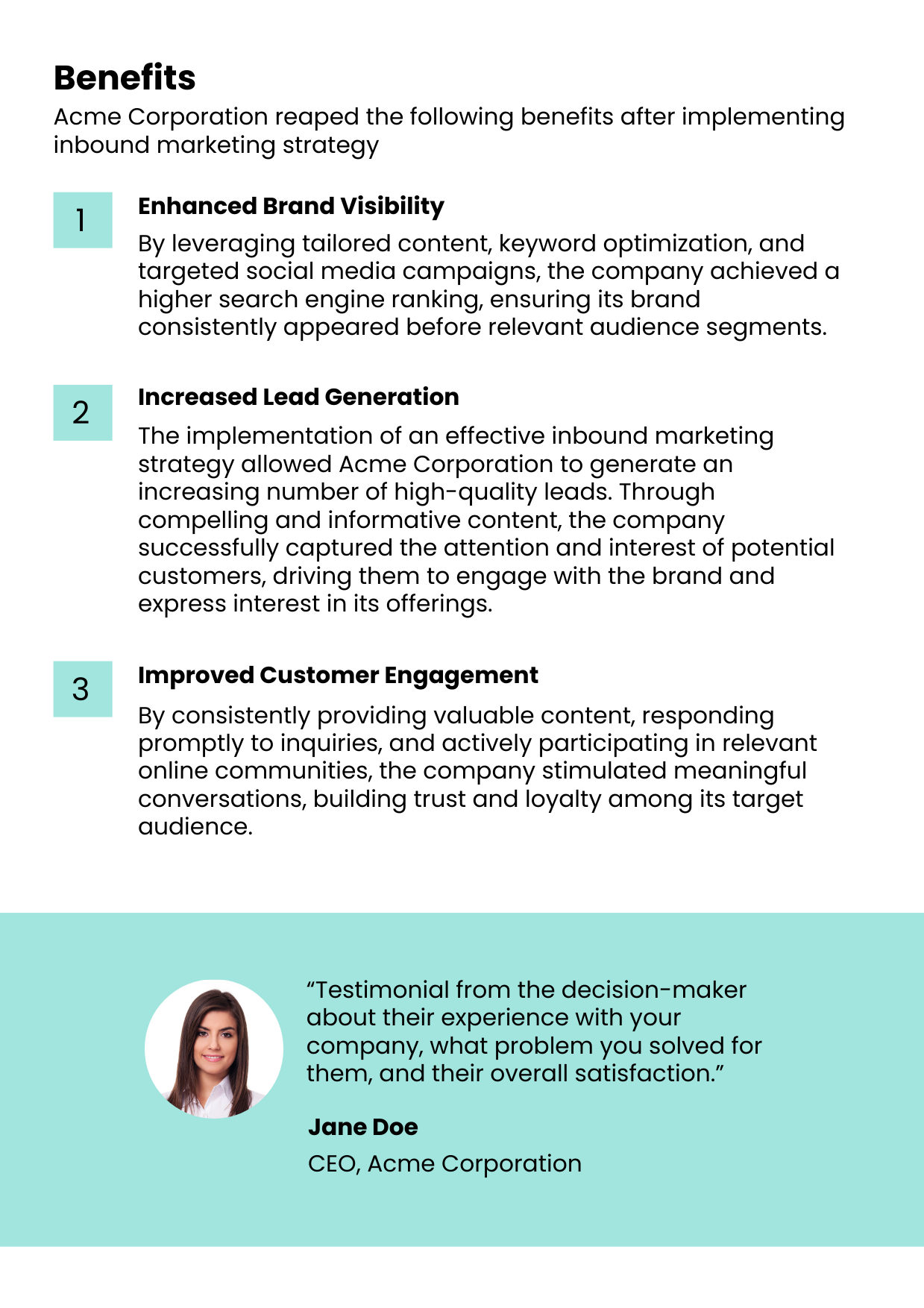
10. Pick an Interesting Angle
Find a unique angle that makes your case study stand out. Maybe it’s an unexpected challenge you overcame, or perhaps it’s a particularly innovative solution. Whatever it is, make it intriguing.
11. Make the Key Takeaway Crystal Clear
Your readers should walk away with a clear understanding of the main point of your case study. This takeaway should reinforce your expertise and the value of your solution.
12. Include a Call to Action (CTA)
Don’t leave your readers hanging—tell them what to do next! Include a compelling summary about your company, showcase your happy client base, and conclude the journey with a strong CTA, whether to contact you for a consultation, download a related resource, or learn more about your services on social media, like the following case study template design.
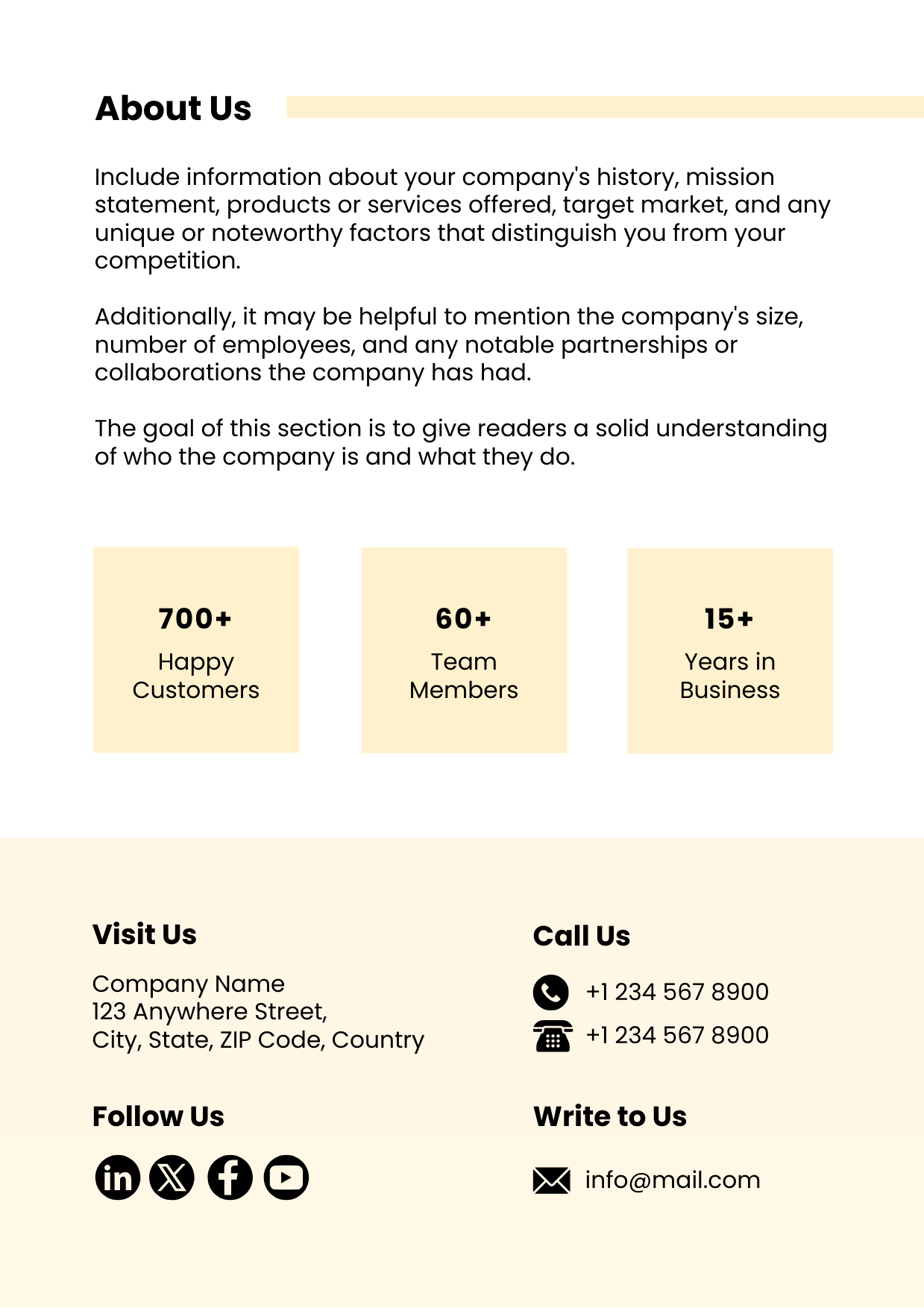
12. Format Professionally
The design of the case study is just as important as the content. A well-formatted, visually appealing document makes a great impression and enhances readability. With ready-to-use niche-oriented templates, you can easily create a professional-looking case study that impresses and converts. Here is an eye-catching template for an AI assistant software case study that displays a sleek and well-navigated format.

13. Make It Readable
Easy readability is key. Use simple language, short paragraphs, and bullet points where appropriate. Your case study should be easy to scan and digest. Follow the thirteen design principles to create a standout piece that enhances your marketing efforts.
To understand this, take a look at the following consulting case study template.

14. Finalize and Proofread Your Case Study
In order to excel in how to write case studies, give your case study a final review before you hit publish. Proofread carefully to catch any typos or errors, and make sure everything flows smoothly. A polished case study reflects your attention to detail and professionalism.
To effectively summarize a case study, start by completing all sections, including the introduction, challenges, solutions, and results. This approach helps marketers identify key points to highlight, making it easier to craft a succinct and engaging summary.
One tricky thing is the length of the case study summary. So, how long should a case study summary be?
The length of a case study summary can vary depending on the details you’re covering. Generally, it should be kept concise, usually spanning a couple of lines or up to a single page with several paragraphs. If you’re crafting a customer case study and want to flex your storytelling muscles, it’s perfectly fine for the summary to stretch to a full page.
If summarizing a case study seems daunting, try DocHipo’s advanced AI Writer tool, which effortlessly creates a crisp and concise summary.
Watch this short video to use it.
This is the last step in writing a case study analysis. Citation in a case study is the practice of giving proper credit to the sources you reference or use in your research. It helps validate your work, shows the depth of your research, and avoids plagiarism. Follow the below steps to cite a case study:
- Identify the Source: Gather details like the author, title, publication year, and where the case study was published.
- Choose a Citation Style: Follow the specific formatting style (APA, MLA, Chicago, etc.) required for your work.
- Format the Citation: Arrange the details according to the chosen citation style.
- Include In-Text Citations: Place citations within the text or paragraphs for the case study.
- Create a References List: At the end of your case study, compile all your sources in a bibliography or reference list.
For case studies, citations in APA and MLA styles are very common. If you are just beginning, then you might be confused about these case study citation formats.
Hence, take a look at the picture below, which easily comprehends the APA vs MLA citation features.
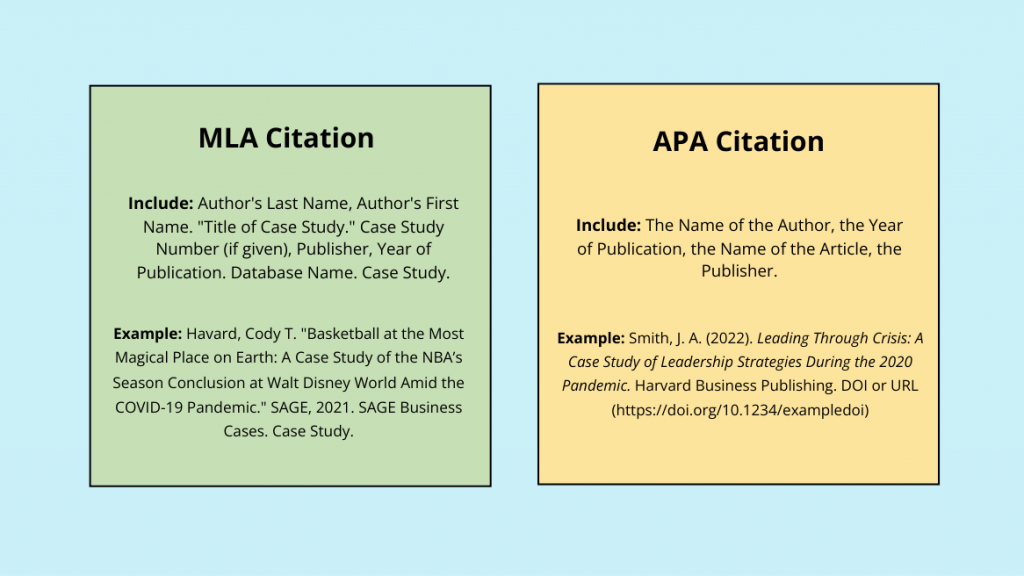
Still feeling overwhelmed about case studies? Be stress-free with the most convenient case study maker, which saves time and allows you to present data in the most attention-grabbing way.
Watch the video to create case studies in minutes with DocHipo’s case study maker.
Conclusion
To summarize, if you want to write a case study, start with a proper case study format, plan the case study, and finally write it with all the information in hand. Then, write a summary to provide an overview of your case study, and finally, add citations for reference.
Meanwhile, if you want to design a case study, Try DocHipo templates. Sign up to explore all the case study templates.
What is the structure of a case study?
A case study typically includes the following sections: Title, Introduction, Background, Problem Statement, Solutions, Results, and Conclusion. Each section serves to tell a comprehensive story of the business, from the issue at hand to the resolution and outcomes.
What are the 5 essential elements of a great case study?
The 5 essential elements are: 1) Clear Objective, 2) Detailed Background, 3) Specific Challenges, 4) Effective Solutions, and 5) Measurable Results. These components provide a compelling narrative that highlights the value delivered.
How to begin a case study?
Start a case study by defining the purpose and scope of the study. Introduce the subject, outline the problem, and provide background information to give readers context. This sets the stage for the detailed analysis that follows.
How to make an introduction in case study?
To craft a compelling introduction, briefly describe the subject, outline the problem they faced, and explain why the study is relevant. This section should grab the reader’s attention and make them interested in the rest of the study.
How to make a business case study?
A business case study should begin with a clear objective and background information. Identify the problem, explain the solutions implemented, and conclude with the results achieved. Use real data and quotes from stakeholders to enhance credibility.
How to write a case study step by step?
To write a case study step by step, start by identifying the case you want to explore and gathering relevant data on the subject. Outline the structure of your case study, then craft an engaging Introduction to set the context. Next, detail the Background and Challenges faced, followed by the Solutions applied. Share the Results and Conclusion to highlight the impact. Finally, edit and proofread your case study to ensure clarity and accuracy.

Turn your ideas into beautiful design
No prior design skill required

Talk to Sales
Wherever you are on your Dochipo journey, you can always get in touch.

Talk to Support

- Special Collections Home
- Archives Home
- Madrid Home
- Assessement
- Contact/Directory
- Library Associates
- Archives & Digital Services
- Databases - Article Linker FAQ
- Digital Collections
- Government Information
- Library Catalog
- Library Catalog - Alerts/Other Material
- Locating Materials in Pius Library
- Meet your Librarian
- SLU Journals and SLU Edited Journals
- SLUth Search Plus
- Special Collections
- Research Guides
- Academic Technology Commons
- Course Reserves
- Course Reserves FAQ
- Interlibrary Loan
- Journal Articles on Demand
- Library Access
- library Account
- Library Instructions
- Library Resources for Faculty and Staff
- Off Campus Library Access
- Questions? Ask Us!
- Study Space and Lockers
- Writing Program Information Literacy Instruction
- Pius Faculty and Staff
- Meet Your Pius Research Librarian
- MCL Faculty and Staff
- Meet Your MCL Liaison Librarian
CORE 1000: Introduction to Future Studies
- APA Citation Style Information
- ATC & Study Space Information
University Writing Services
- University Writing Services "Whether you are brainstorming your first assignment at Saint Louis University or putting the final touches on your dissertation, SLU's University Writing Services can offer individualized feedback on your writing and composition process."
Plagiarism Prevention
Learn more at the slu academic integrity pages, slu academic integrity policy, helpful apa citation style sources.
In addition to the sources below, check out SLU Librarian Jamie Emery's guide Style Guides & Manuals , including resources for APA, MLA, Chicago & more.
Includes information on APA style citations, as well as information on other citation styles and formatting. This site also includes a variety of other useful writing related information.
APA (American Psychological Association) style is most commonly used to cite sources within the social sciences. This resource, revised according to the 7th edition of the APA manual, offers examples for the general format of APA research papers, in-text citations, endnotes/footnotes, and the reference page. For more information, please consult the Publication Manual of the American Psychological Association, (7th ed.).
This poster created by Purdue Owl summarizes APA style in a visual format.
The style and grammar guidelines pages present information about APA Style as described in the Publication Manual of the American Psychological Association, Seventh Edition and the Concise Guide to APA Style, Seventh Edition.
- << Previous: Home
- Next: ATC & Study Space Information >>
- Last Updated: Aug 29, 2024 4:10 PM
- URL: https://libguides.slu.edu/futurestudies

IMAGES
VIDEO
COMMENTS
3 Writing a case study in APA Step By Step. 3.1 Title Page in APA for Case Study Project. 3.2 APA Title Page Example. 3.3 The Abstract for an APA case study. Whether you study social sciences or life sciences, you're likely to encounter a case study analysis in your academic journey. These papers demand a lot from students.
These sample papers demonstrate APA Style formatting standards for different student paper types. Students may write the same types of papers as professional authors (e.g., quantitative studies, literature reviews) or other types of papers for course assignments (e.g., reaction or response papers, discussion posts), dissertations, and theses.
Media Files: APA Sample Student Paper , APA Sample Professional Paper This resource is enhanced by Acrobat PDF files. Download the free Acrobat Reader. Note: The APA Publication Manual, 7 th Edition specifies different formatting conventions for student and professional papers (i.e., papers written for credit in a course and papers intended for scholarly publication).
Case Study Format Template. Case studies can be used for different purposes. In social sciences, it can help you understand the problems of other people. In businesses, it can help you earn the trust of potential customers. ... Here is a case study APA format example for you to learn how to format a case study. APA Case Study Format.
Indent the first line of every paragraph of text 0.5 in. using the tab key or the paragraph-formatting function of your word-processing program. Page numbers: Put a page number in the top right corner of every page, including the title page or cover page, which is page 1. Student papers do not require a running head on any page.
This should be placed on the second page of your case study paper, should not be more than 150-200 words, and needs to be written in a one-block paragraph. 4. Follow the right format. The body of the case study paper should be thorough and should detail the research and findings in an engaging manner.
Throughout your paper, you need to apply the following APA format guidelines: Set page margins to 1 inch on all sides. Double-space all text, including headings. Indent the first line of every paragraph 0.5 inches. Use an accessible font (e.g., Times New Roman 12pt., Arial 11pt., or Georgia 11pt.).
5. Write the abstract. This should be located on page two of your case study, and will contain the four or five most important points that will be discussed in the following pages. For the purposes of the case study, this means the individual or organization under study, the problem addressed, and the questions raised.
APA style recommends that your case study feature a title page, abstract (if required), main body and references. Your running head lies at the top of each page in your header. This should feature your title on the flush left hand side and your page numbers on the flush right hand side. Your title is limited to 50 characters in the running head.
1. Annotated APA Sample Paper and Style Guide for Student Writers (6th Edition) Center and double-space your title, author(s), and institutional affiliation in the top half of your first page (p. 23). If your title runs more than one line (here and on page 3), you may insert a break wherever you want or can just let your title wrap onto a new ...
Basic guidelines for formatting the reference list at the end of a standard APA research paper Author/Authors Rules for handling works by a single author or multiple authors that apply to all APA-style references in your reference list, regardless of the type of work (book, article, electronic resource, etc.)
General format for citing case studies: Author(s). (Year). Title of case study. Number of case study. URL. Examples: Harvard Business School Case Study Smith, S. (2003). ... (Examples courtesy of APA Style Guidelines & Examples - NAIT Library.) Textbook Case Study Author(s) or editor(s) of the chapter or entry or case study. (Year of book).
When you're writing a case study in APA format, having a clear structure helps keep everything organized and easy to follow. It also makes sure you hit all the important points. Let's go through the main sections you need to include, following the APA case study format. Title Page: Start with a title page with the title of your case study, your ...
According to them, your paper needs to be double-spaced. According to the case study format APA, your paper will include an abstract, a main body, and a reference list. Also, it should contain a running head on the top left corner of every page. Also, you have to use Arabic numerals for putting in page numbers.
Identify the key problems and issues in the case study. Formulate and include a thesis statement, summarizing the outcome of your analysis in 1-2 sentences. Background. Set the scene: background information, relevant facts, and the most important issues. Demonstrate that you have researched the problems in this case study. Evaluation of the Case
1. Draft Structure. 🖋️ Your draft should contain at least 4 sections: an introduction; a body where you should include background information, an explanation of why you decided to do this case study, and a presentation of your main findings; a conclusion where you present data; and references. 2. Introduction.
This article walks through the formatting steps needed to create an APA Style student paper, starting with a basic setup that applies to the entire paper (margins, font, line spacing, paragraph alignment and indentation, and page headers). It then covers formatting for the major sections of a student paper: the title page, the text, tables and ...
Reference List Citation. Author's Last Name, Author's First Initial. (Publication Year). Title of case study: Subtitle if any. Case Study Number (if given). Database main URL. Note: If your source has two to twenty authors, include all of the authors' last names, first initials, and second initials (if given) in the Reference List citation.
Generate accurate APA citations with Scribbr. The most important APA format guidelines in the 6th edition are: Use 12 pt Times New Roman. Set 1 inch page margins. Apply double line spacing. Insert a running head on every page. Indent every new paragraph ½ inch.
Sara, a 35-year-old married female. Sara was referred to treatment after having a stillbirth. Sara showed symptoms of grief, or complicated bereavement, and was diagnosed with major depression, recurrent. The clinician recommended interpersonal psychotherapy (IPT) for a duration of 12 weeks. Bleiberg, K.L., & Markowitz, J.C. (2008).
Writing resource. Details. Paper Format. Guidelines for setting up your paper, including the title page, font, and sample papers. Reference Examples. More than 100 reference examples of various types, including articles, books, reports, films, social media, and webpages
What Format to Follow. General APA case study format includes a title page, an abstract, body pages, conclusion and reference list. It also may contain appendixes if the research is large and requires using charts, graphs, and interviews.A title page should include the name of an author, the topic of his work, the name of the university or ...
When citing a case study, the format in MLA and APA is similar to that of a report, and in Chicago style, it is similar to that of a book. ... The templates and examples below will demonstrate how to cite a case study in MLA, APA, and Chicago styles. MLA 9.
Other case studies provide a good template for some aspects of this Evidence-Based Case Study format. Related case studies that effectively address the first two outcome assessment criteria, but lack extensive verbatim clinical vignettes include Borckardt et al., 2008; Jones et al., 1993; and Porcerelli et al., 2007.
Check out the sample case study below for payroll accounting. The details are clearly organized and grouped to emphasize the type of case study. Get This Template and More. Also, the next case study template displays very specific problems that a company faces when it lacks digital marketing expertise. Get This Template and More
APA Formatting & Style Guide by Purdue Owl. APA (American Psychological Association) style is most commonly used to cite sources within the social sciences. This resource, revised according to the 7th edition of the APA manual, offers examples for the general format of APA research papers, in-text citations, endnotes/footnotes, and the ...